
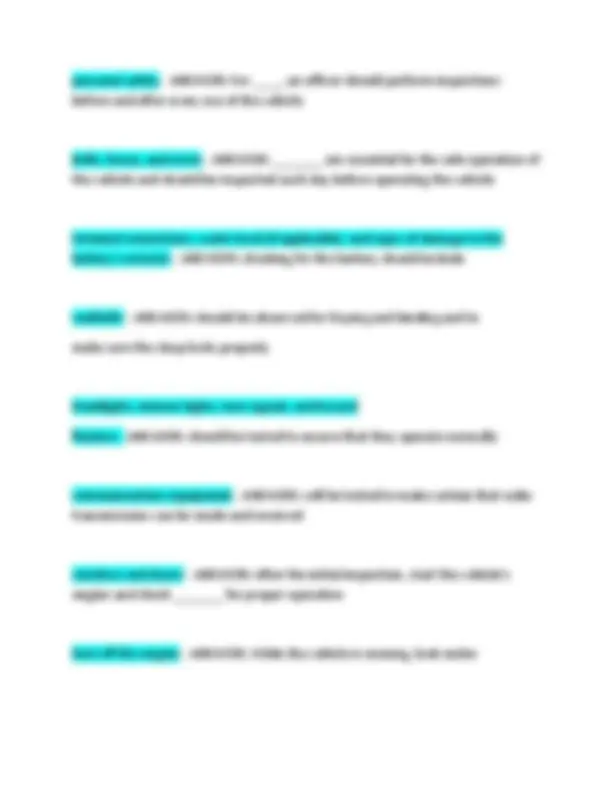
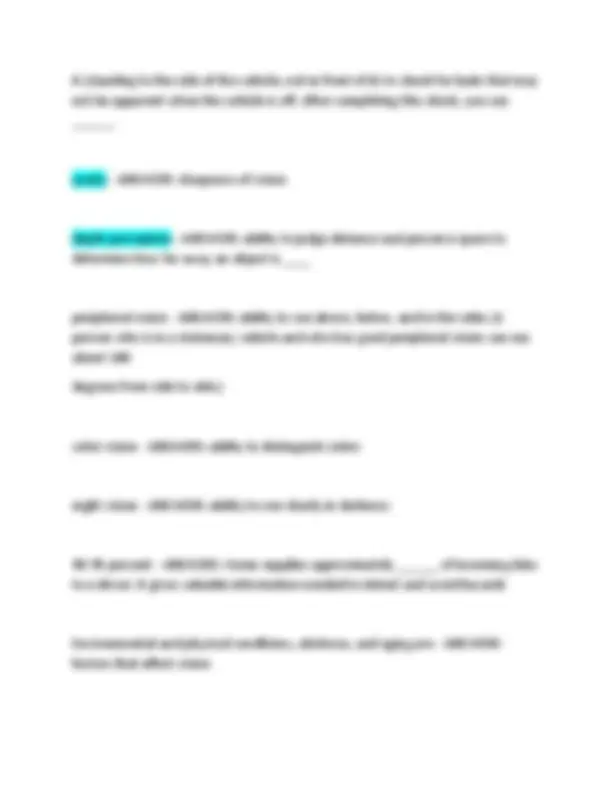
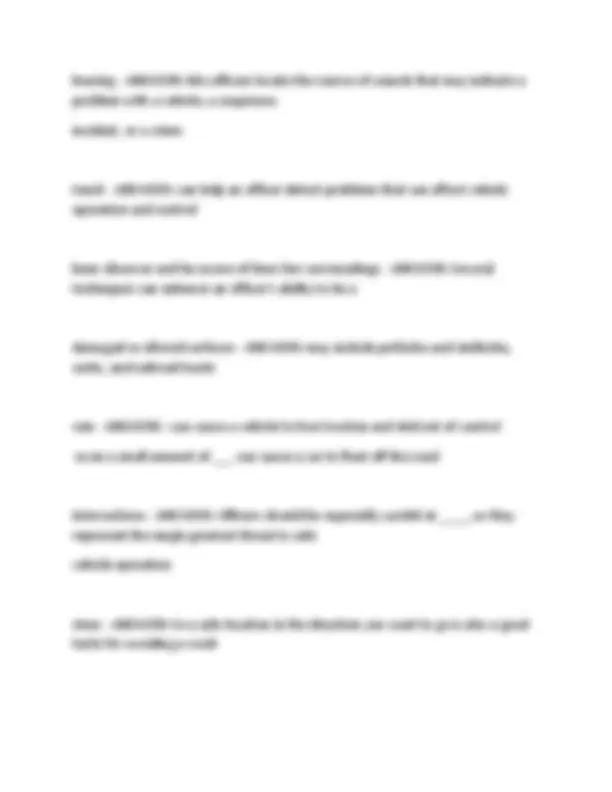
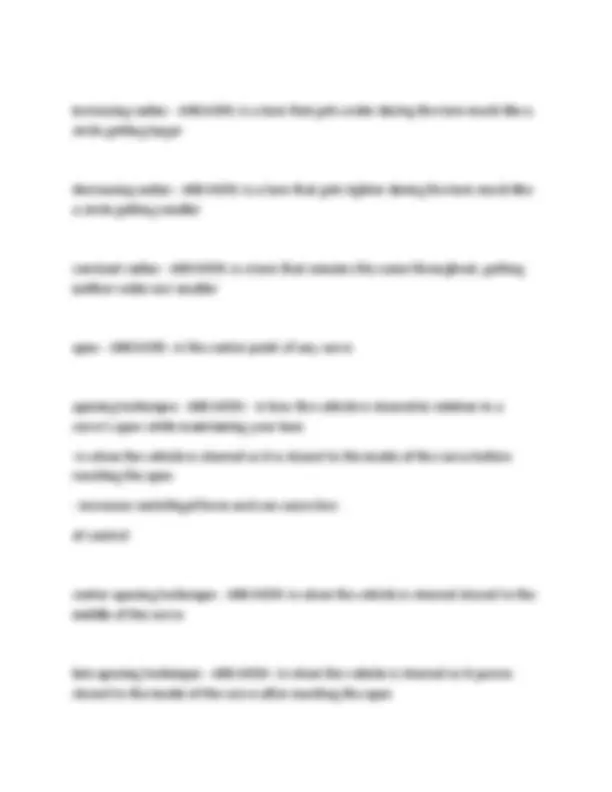
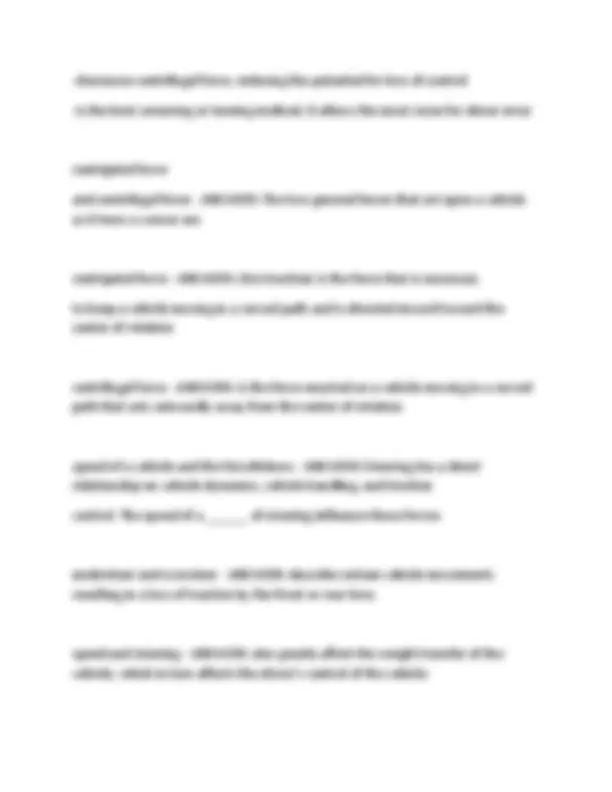
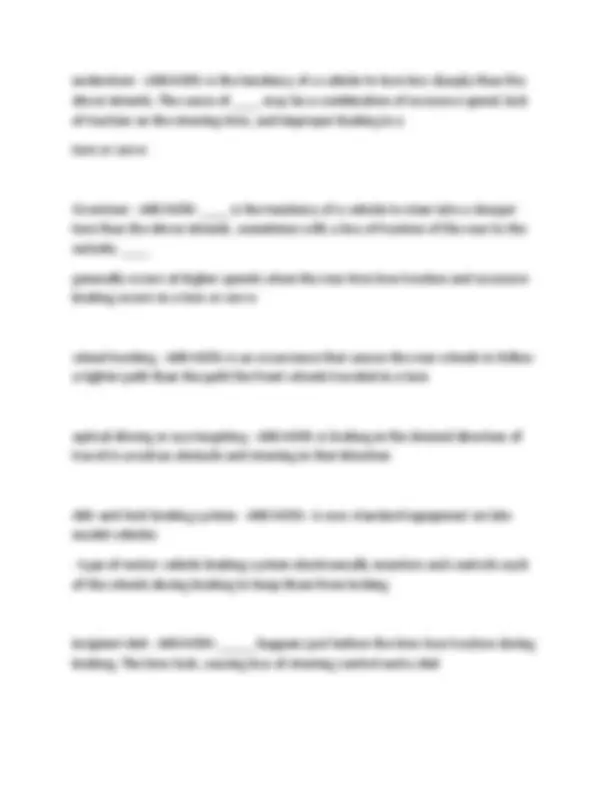
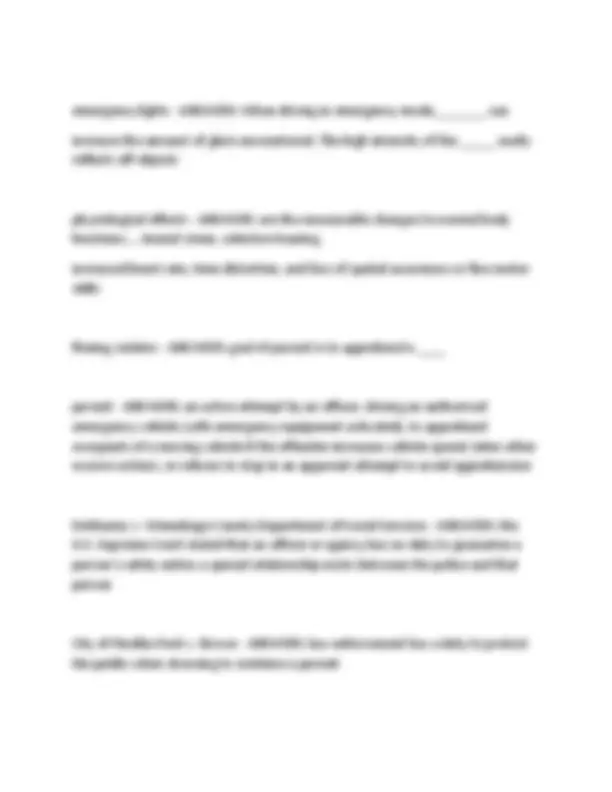
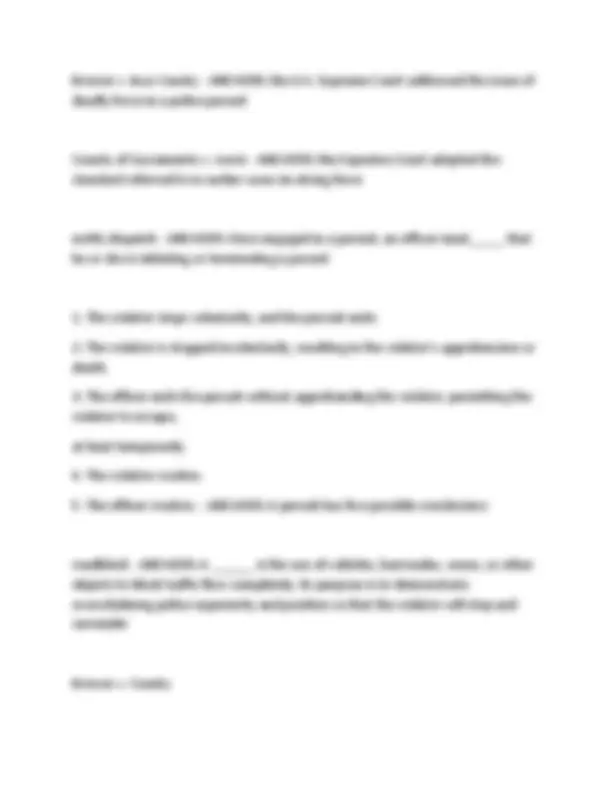
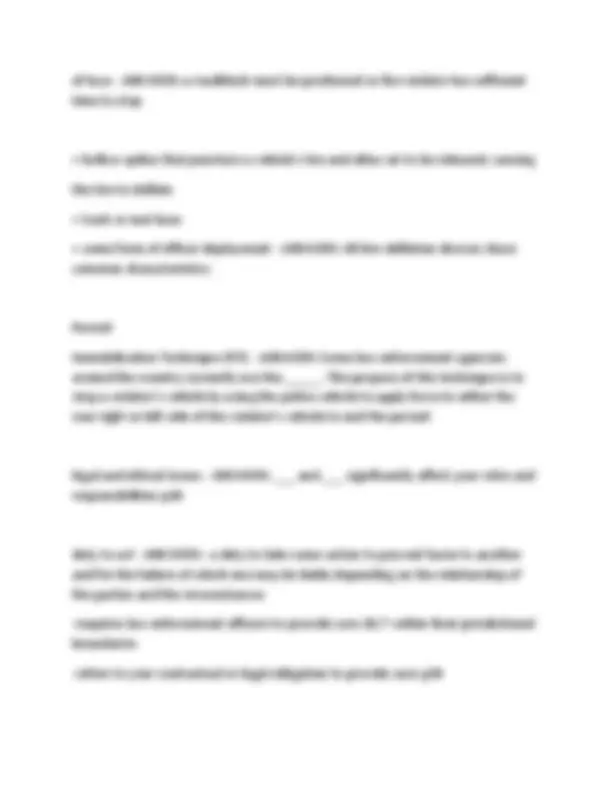
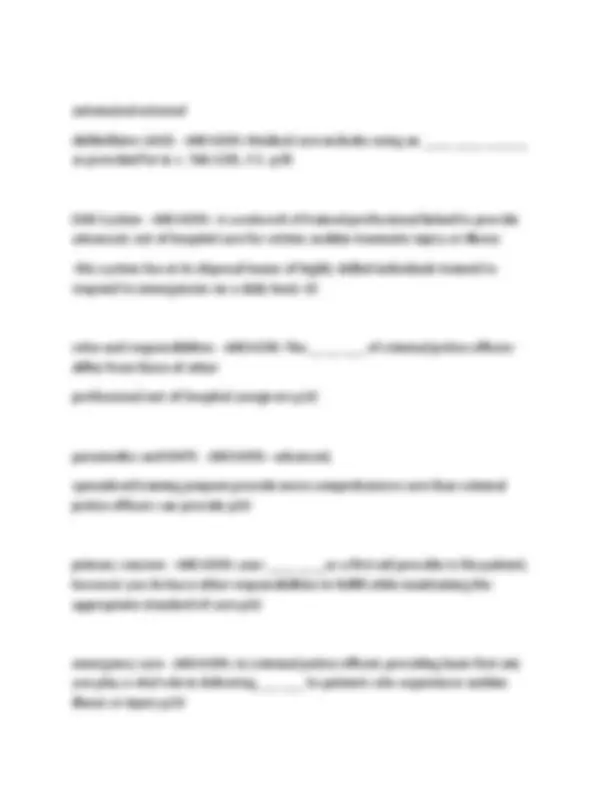
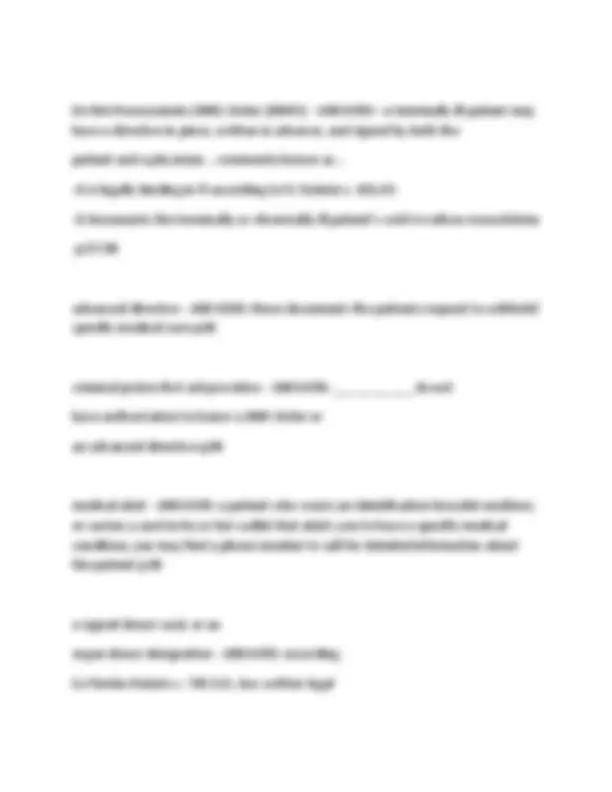
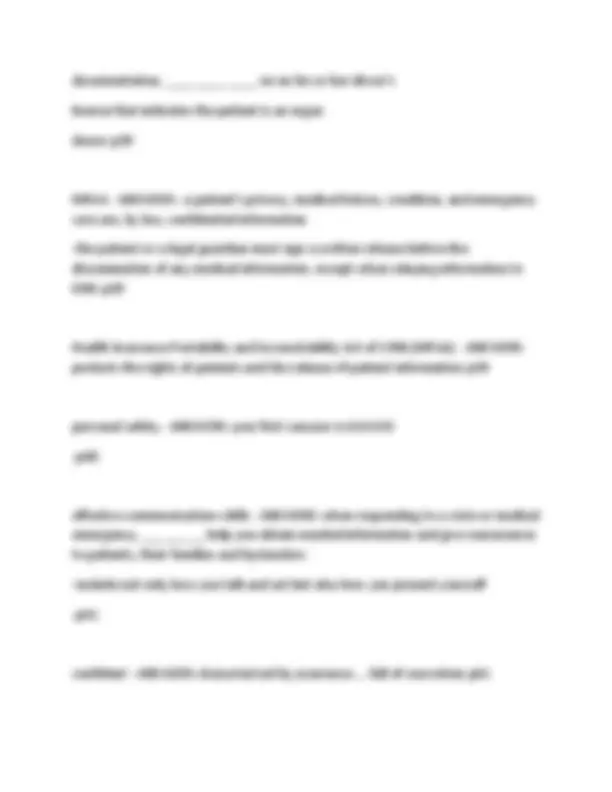
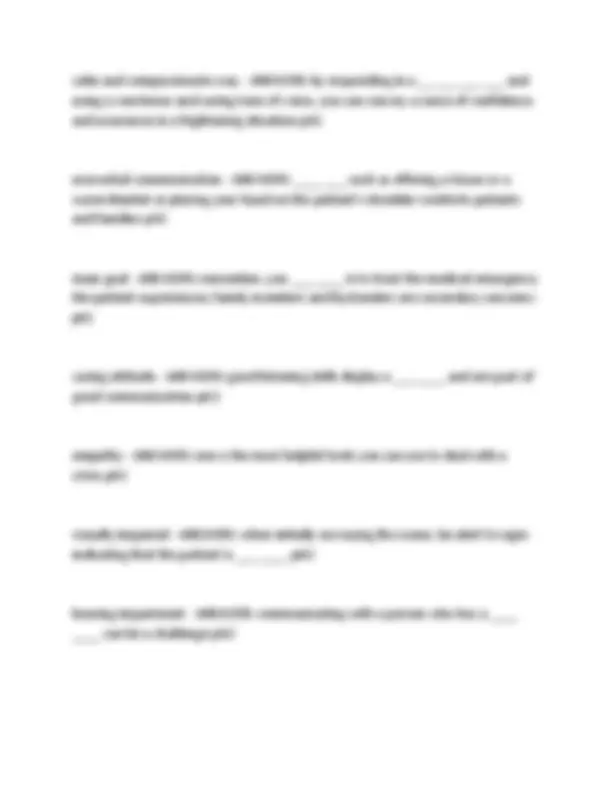
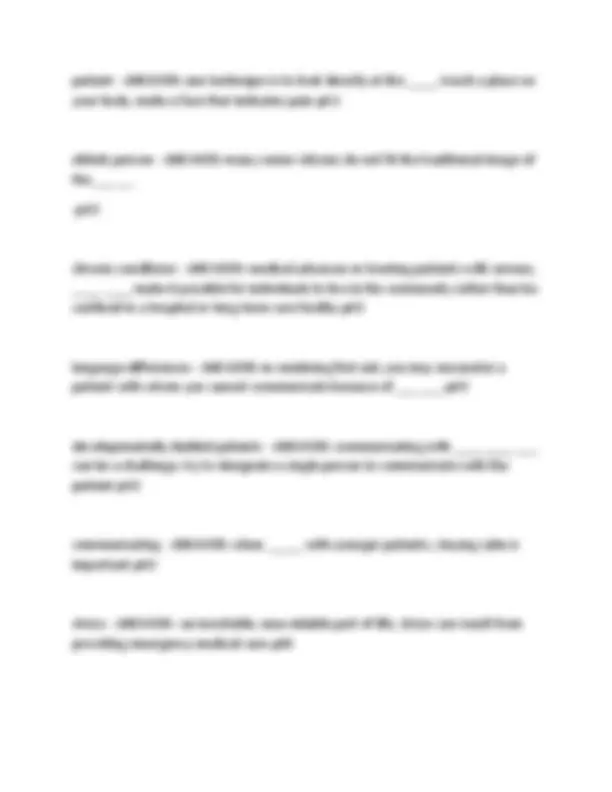
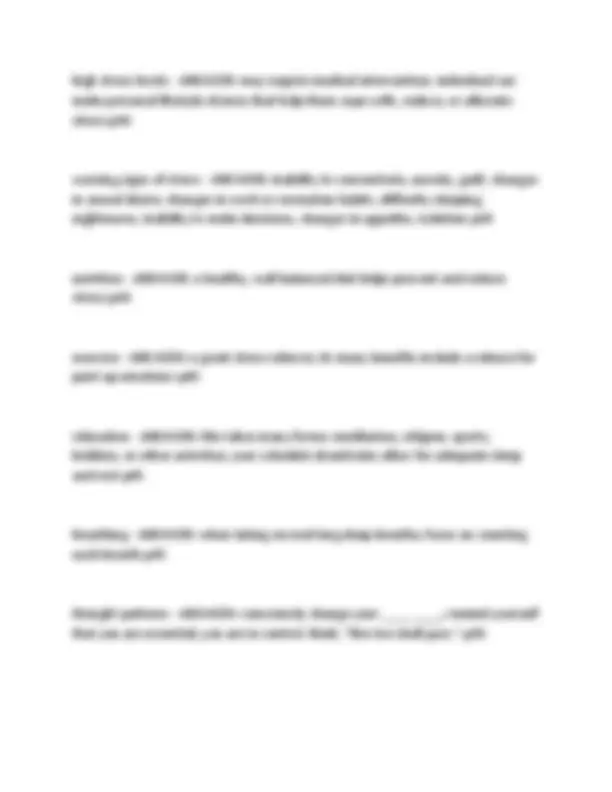
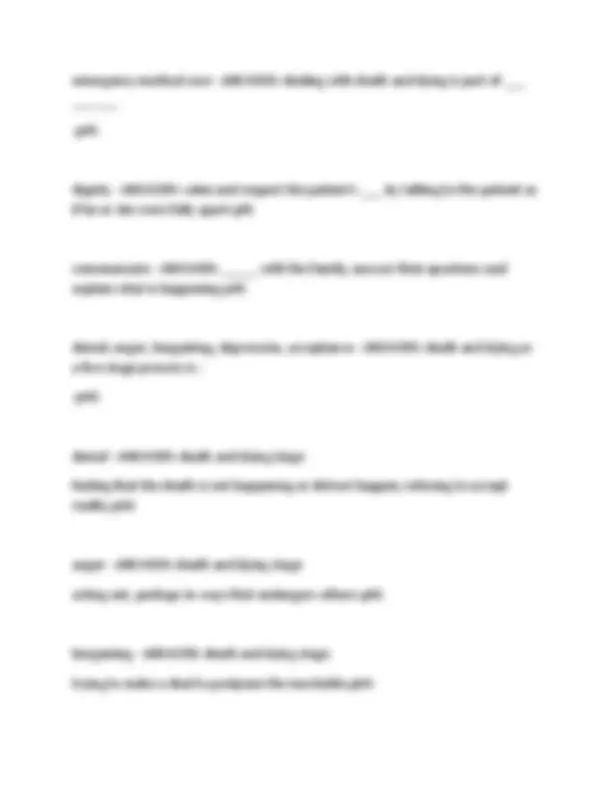
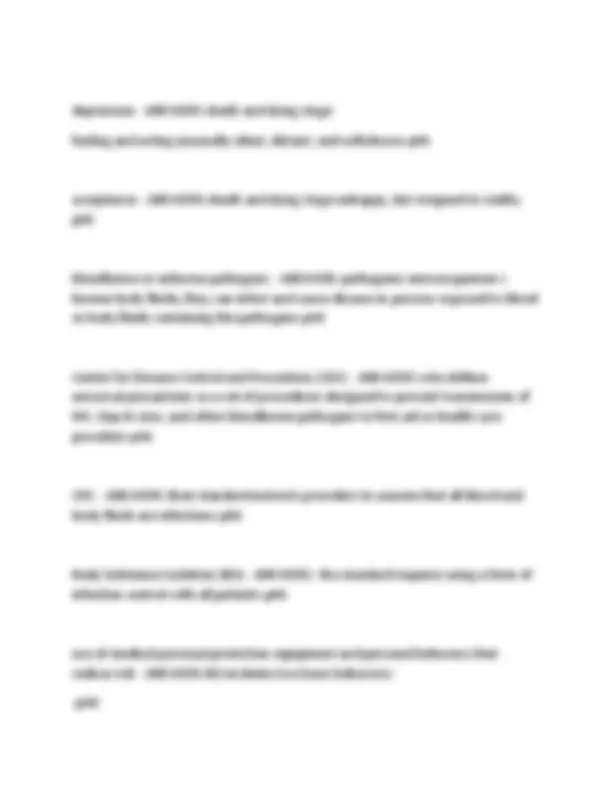
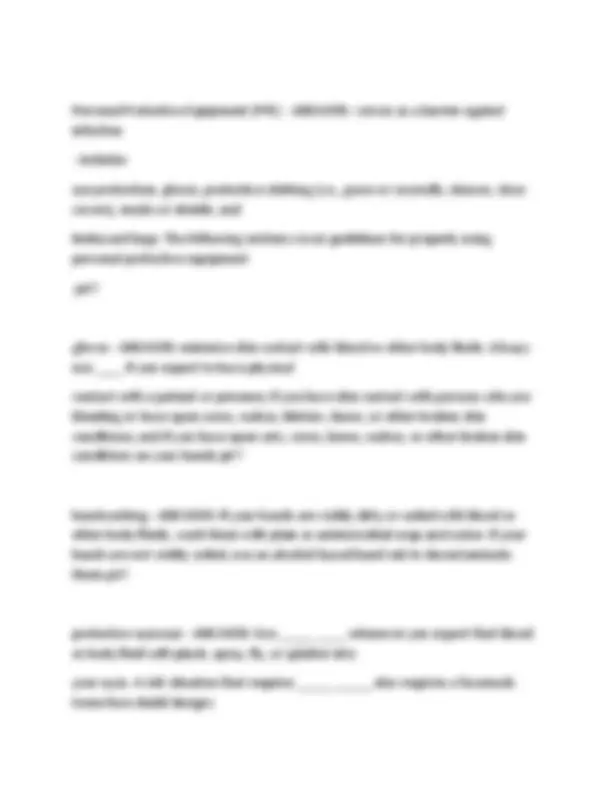
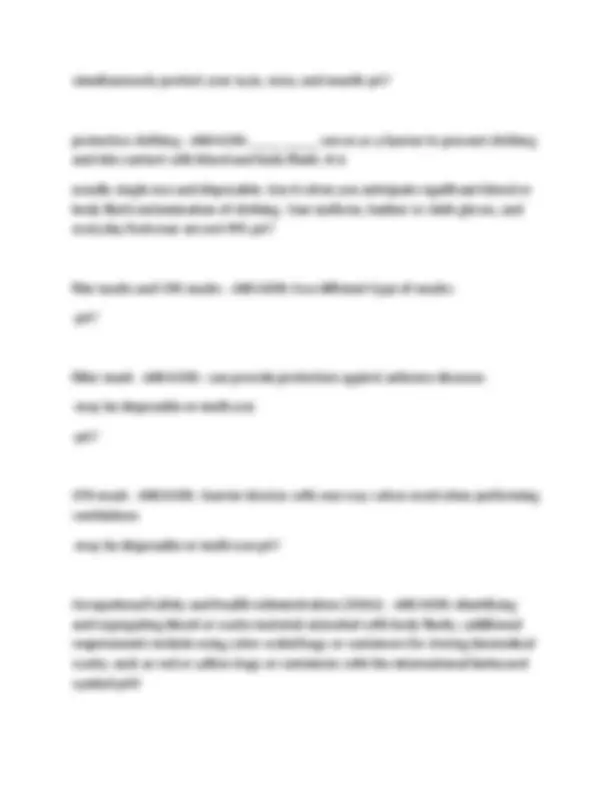
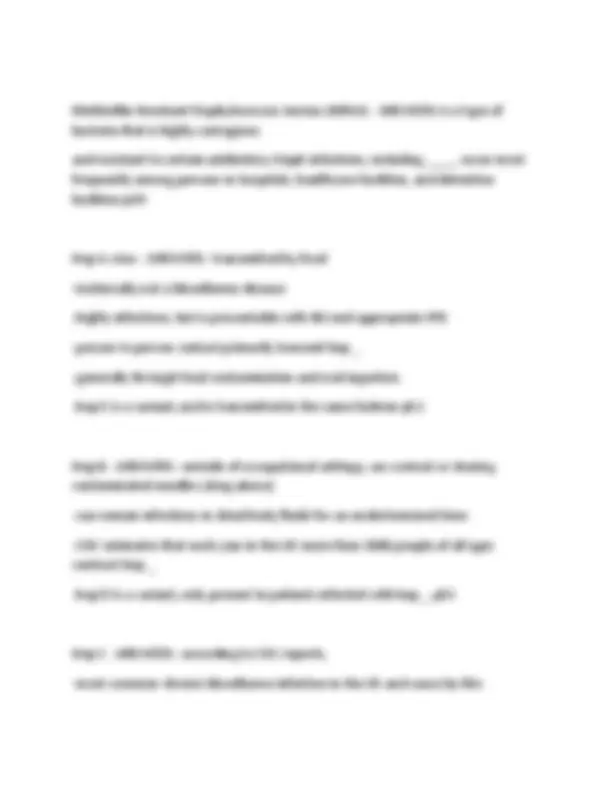
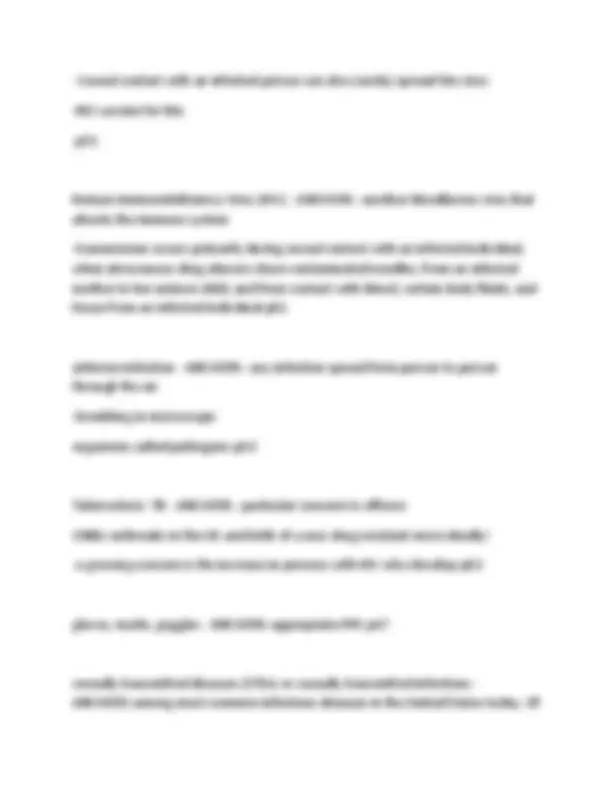
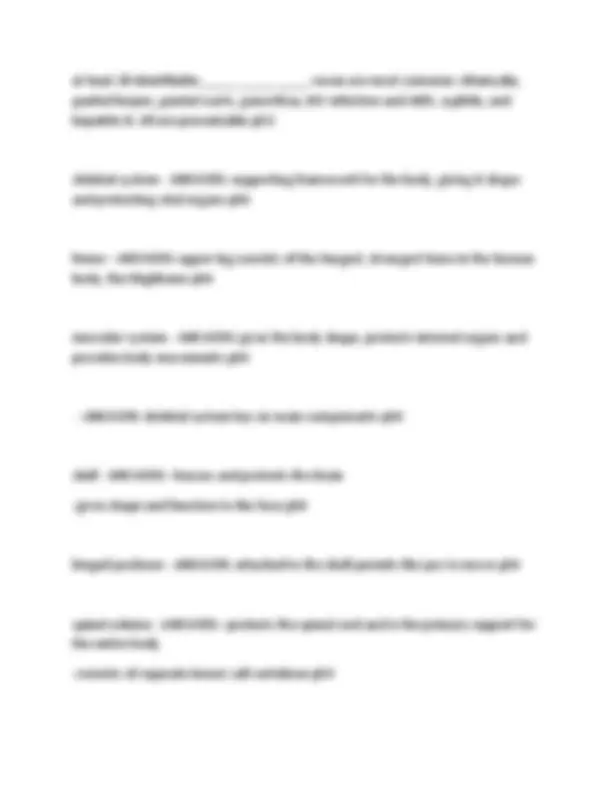
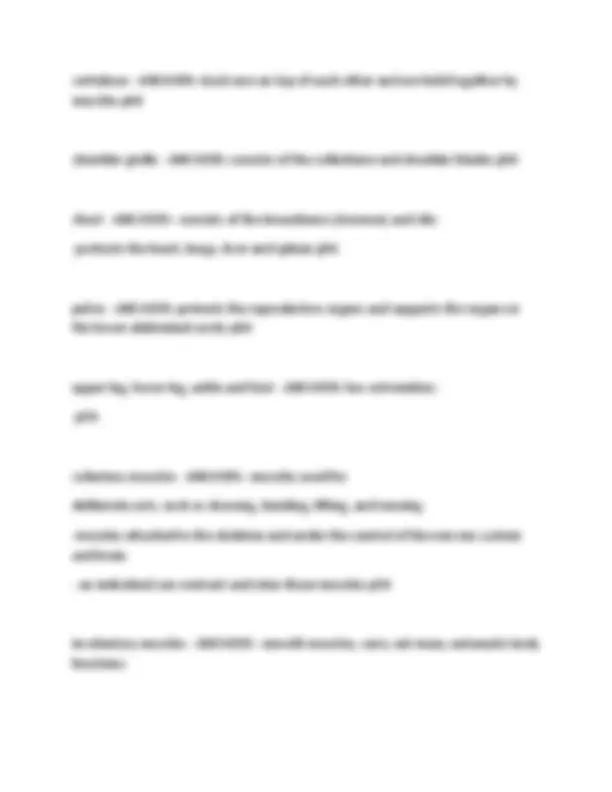
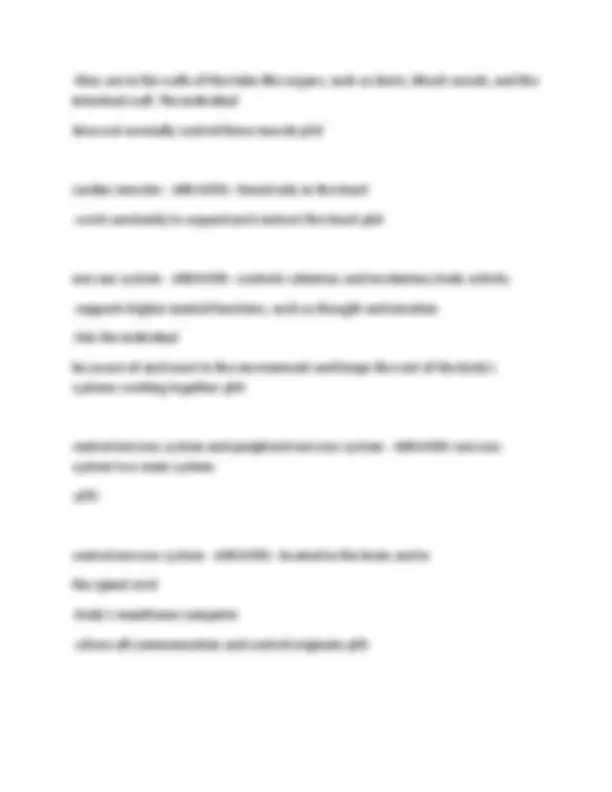
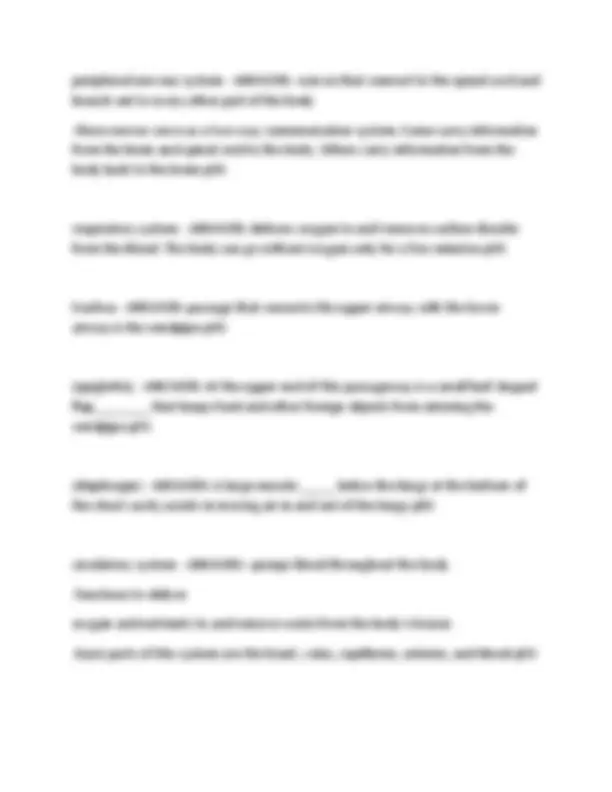
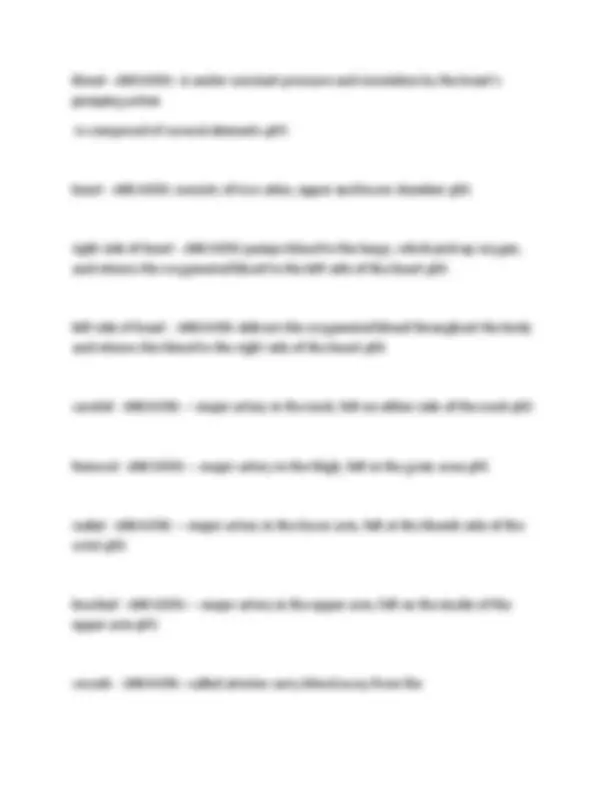
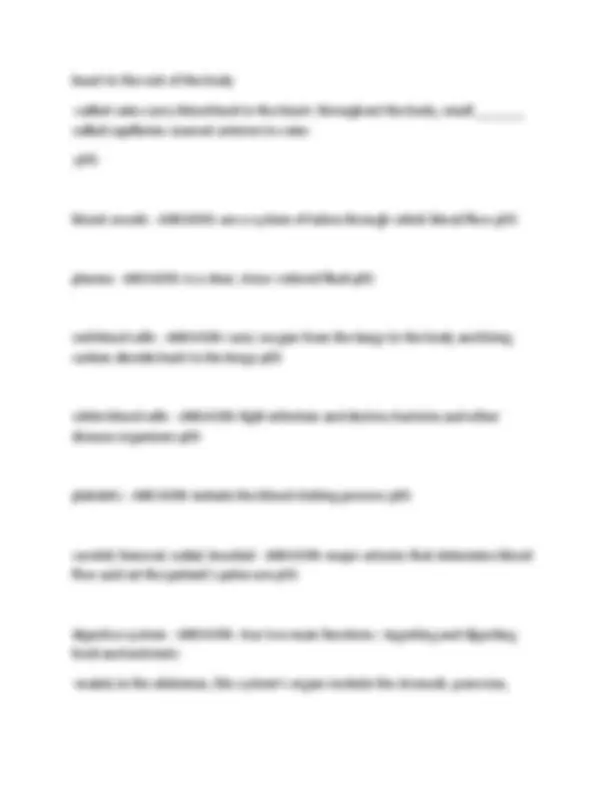
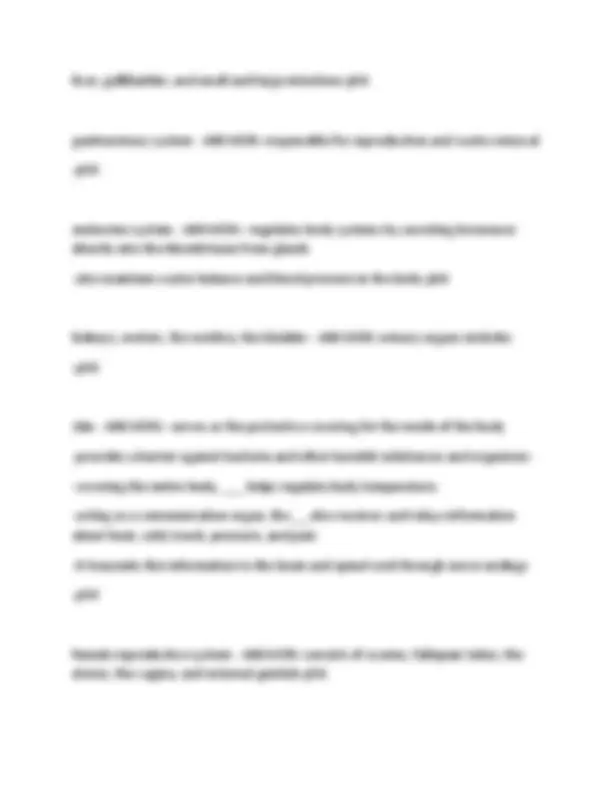
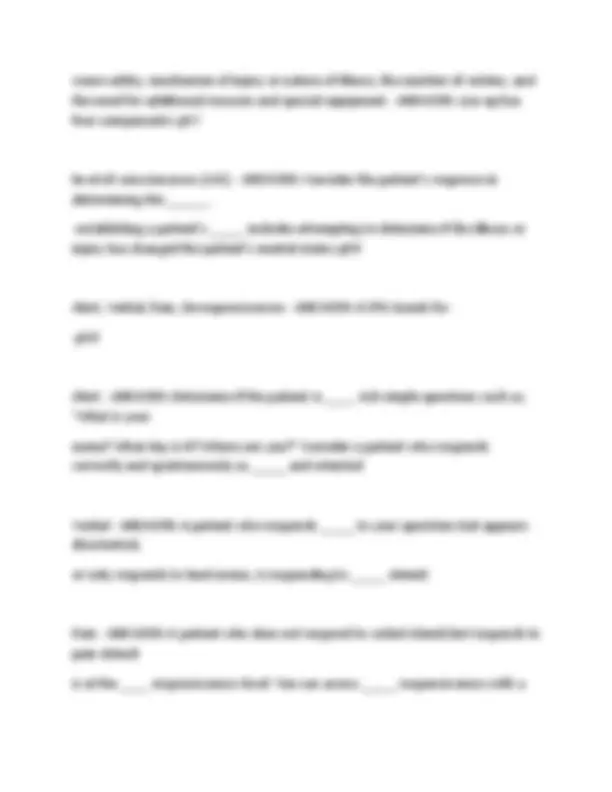
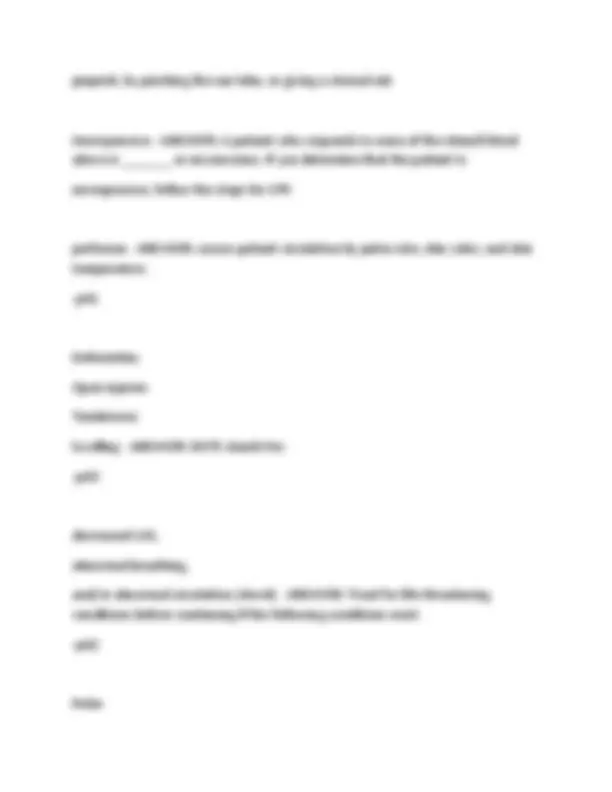
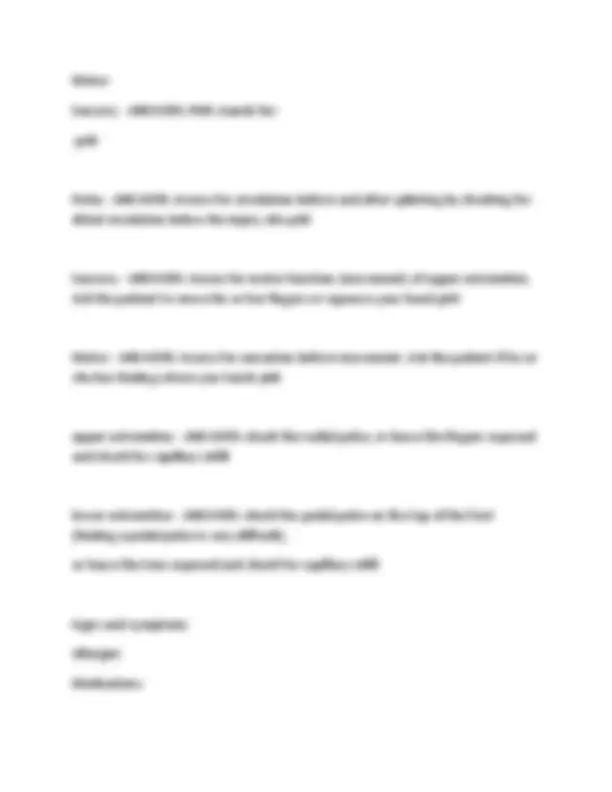
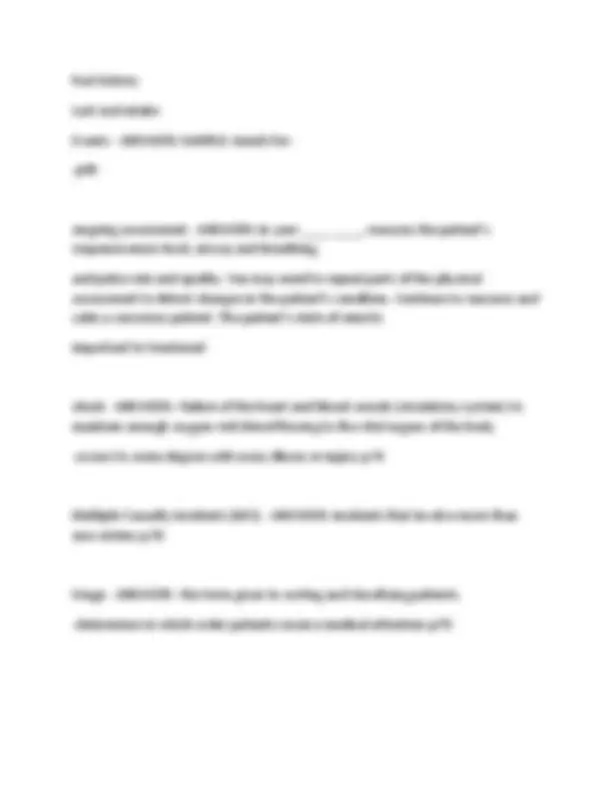
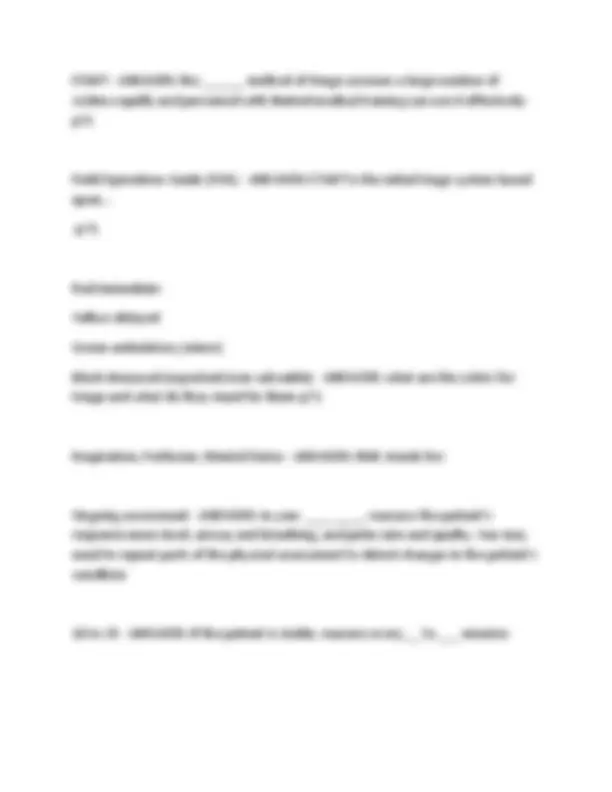
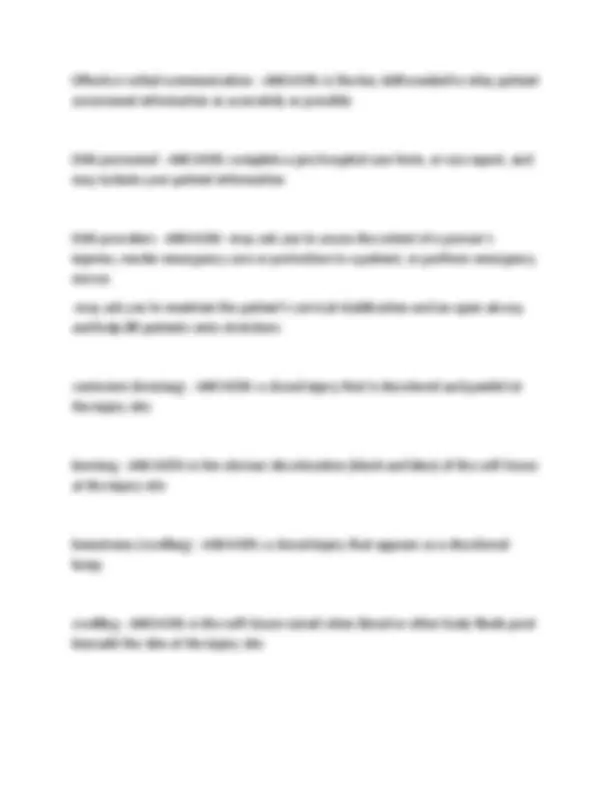
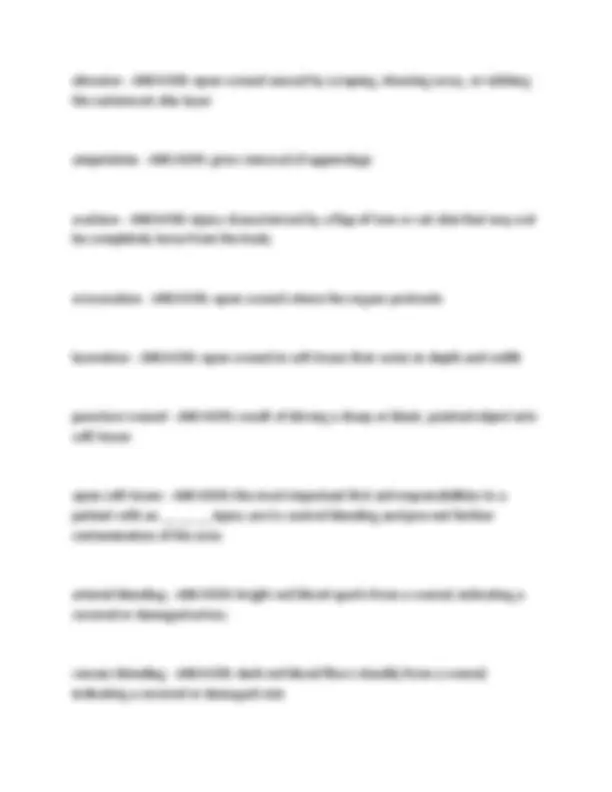
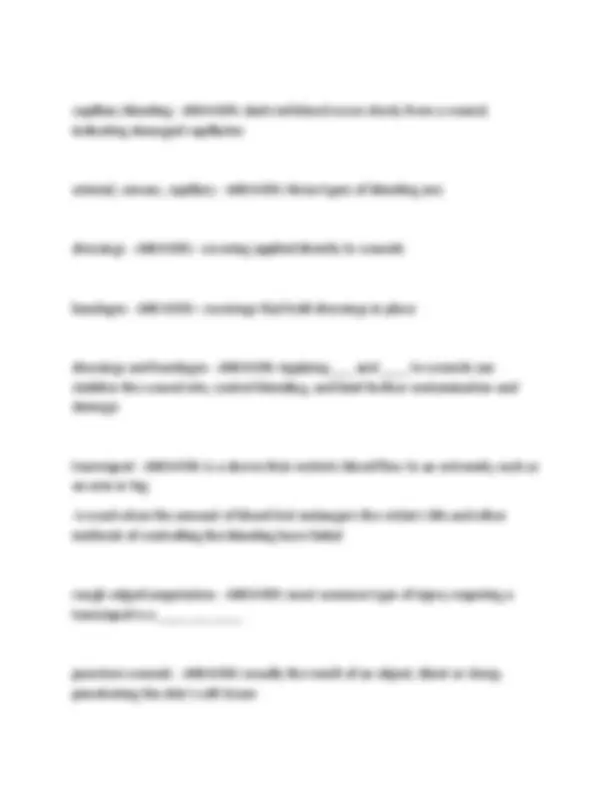
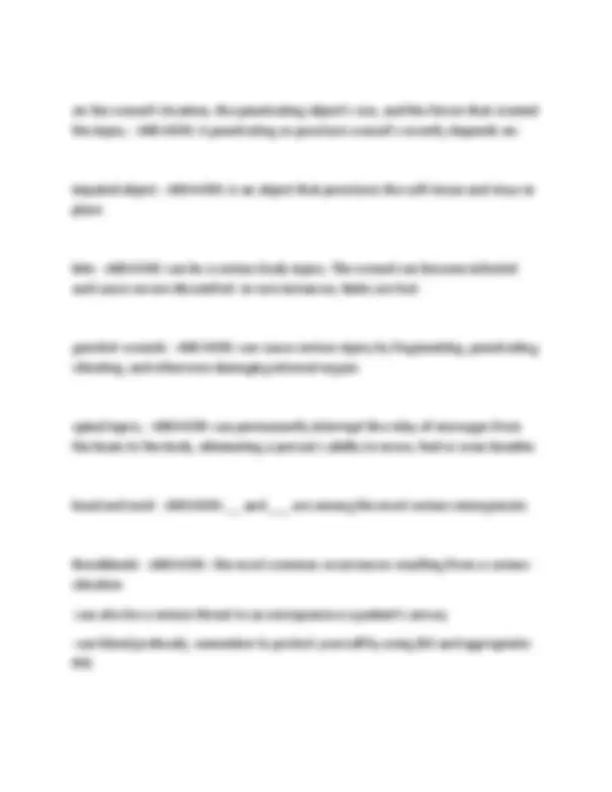
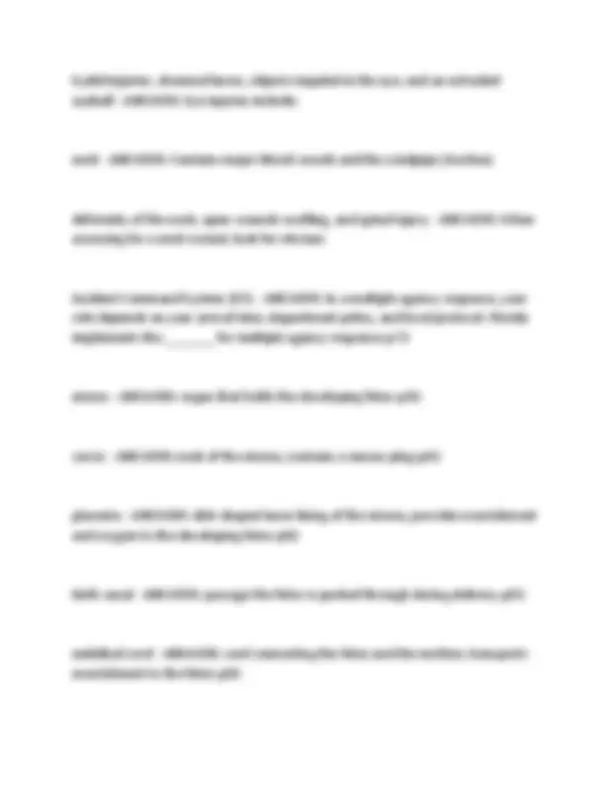
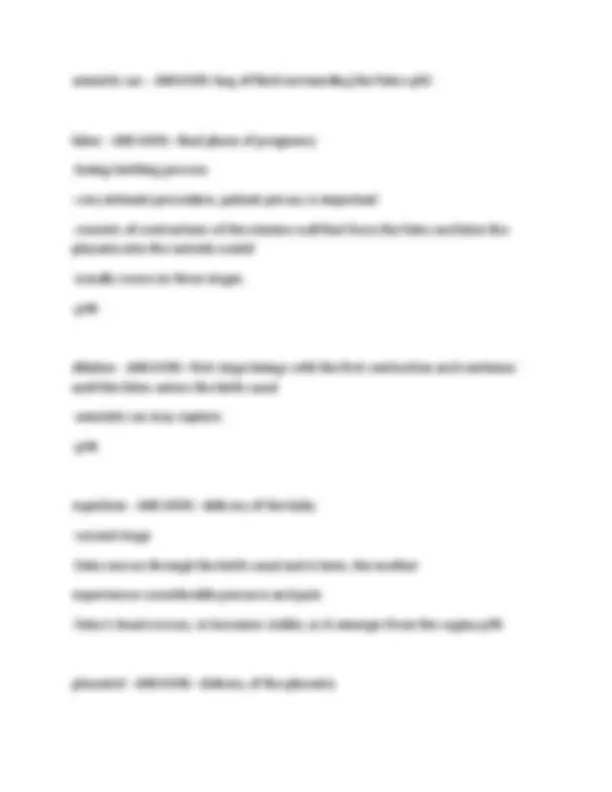
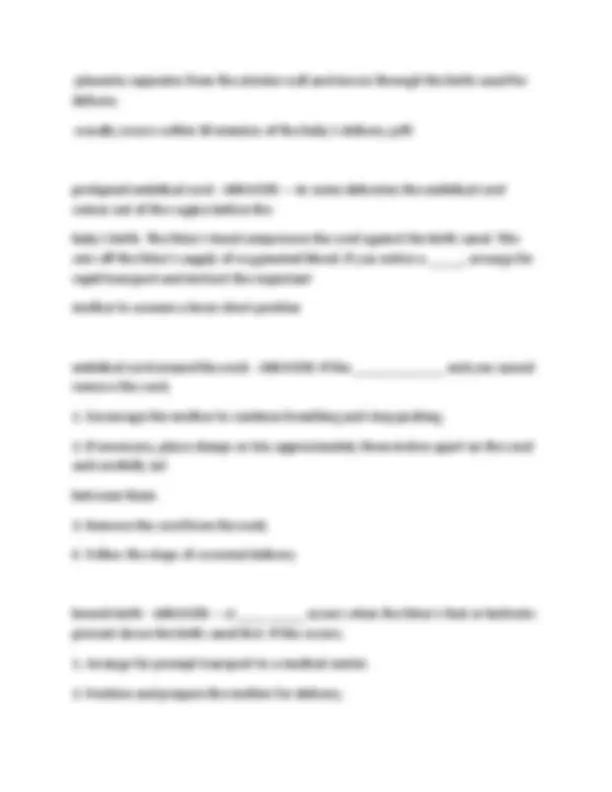
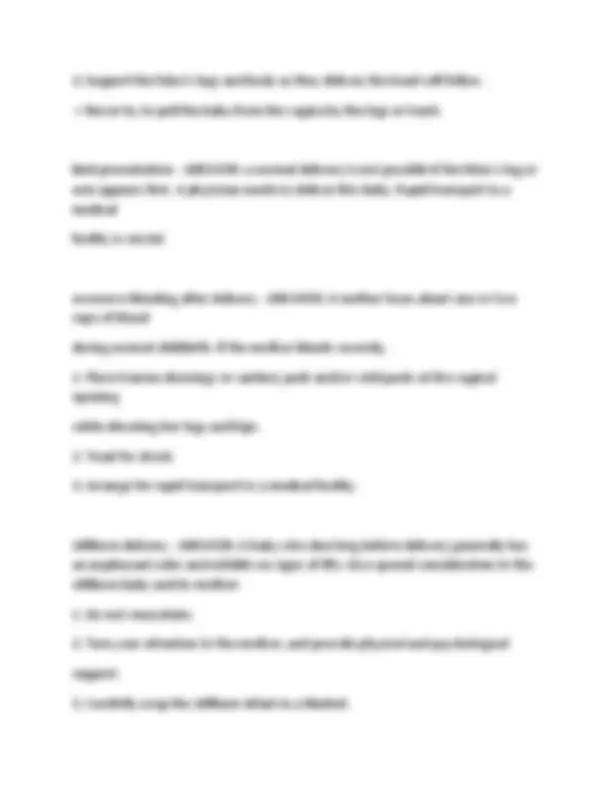
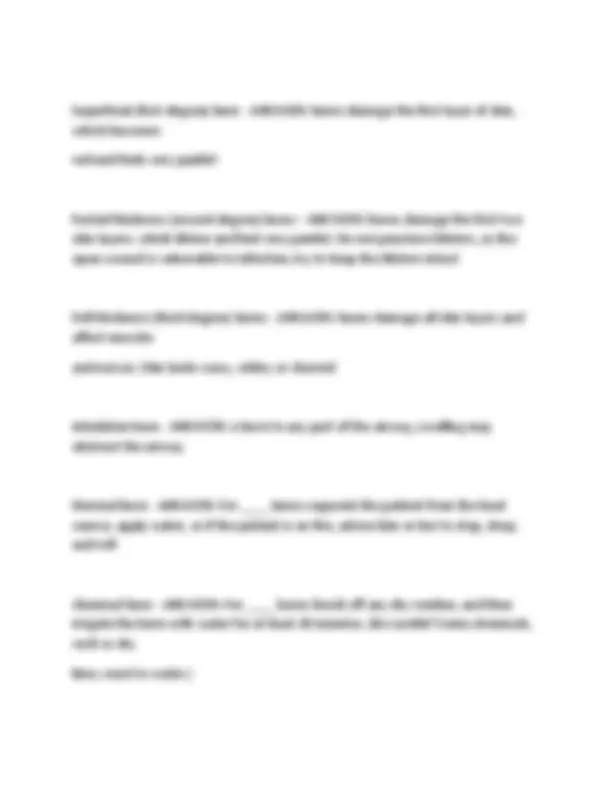
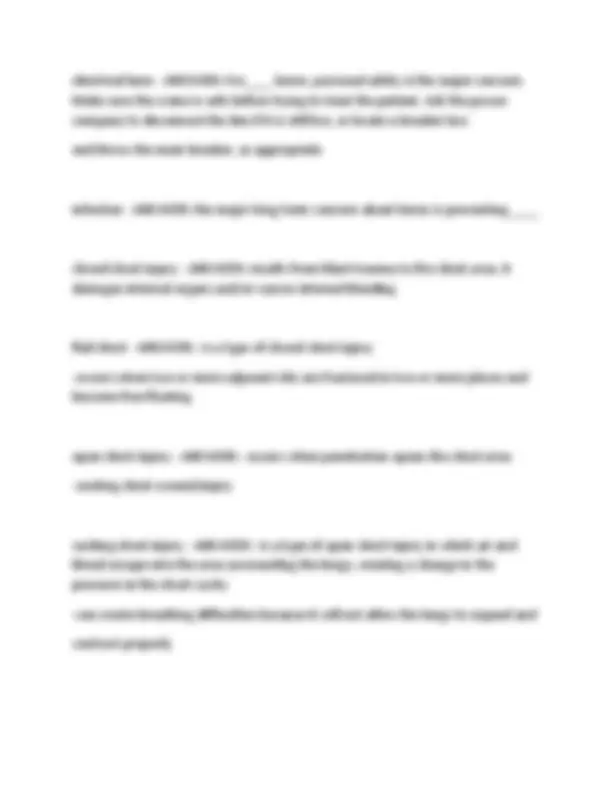
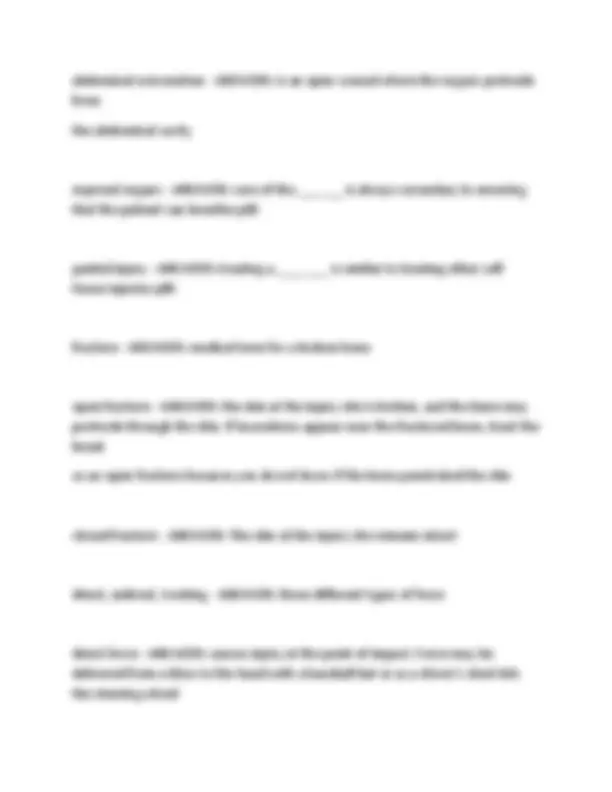
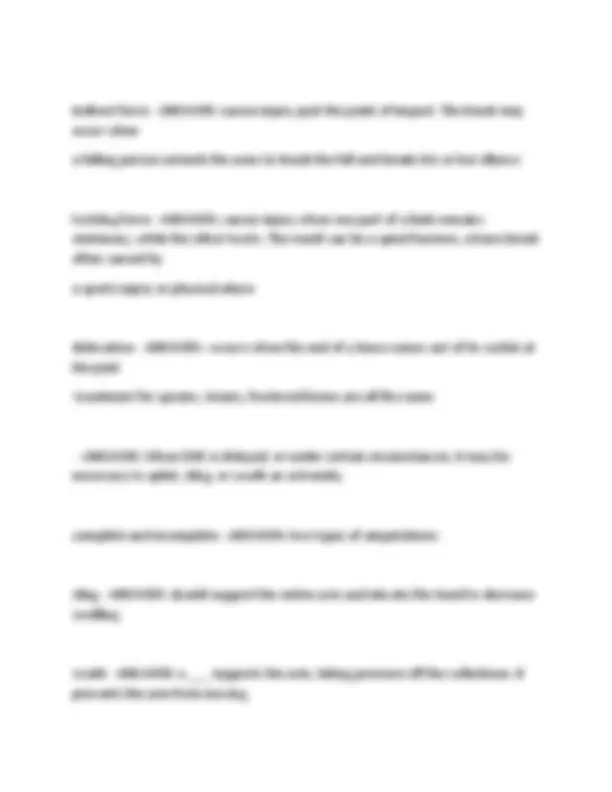
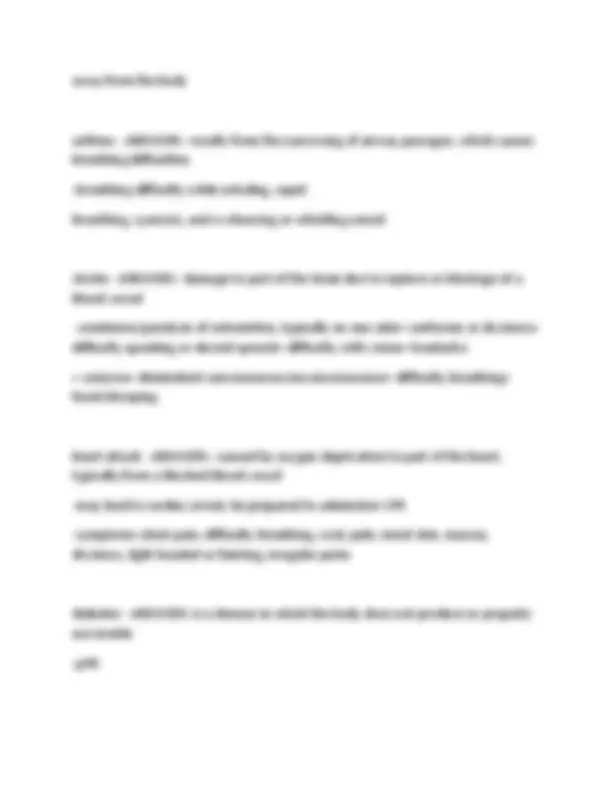
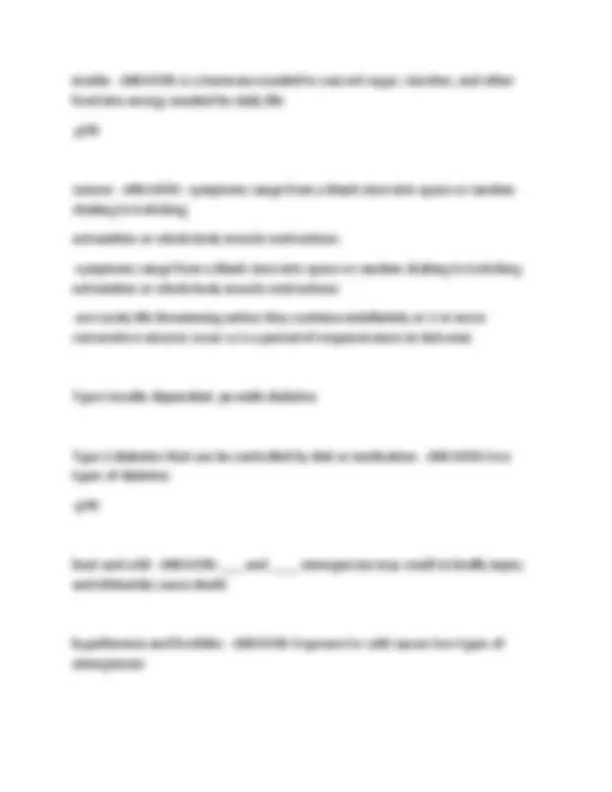
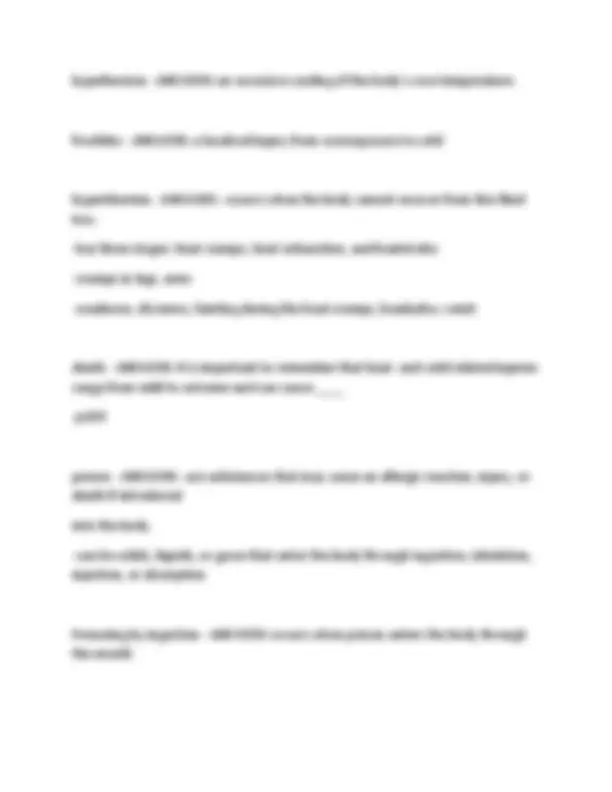
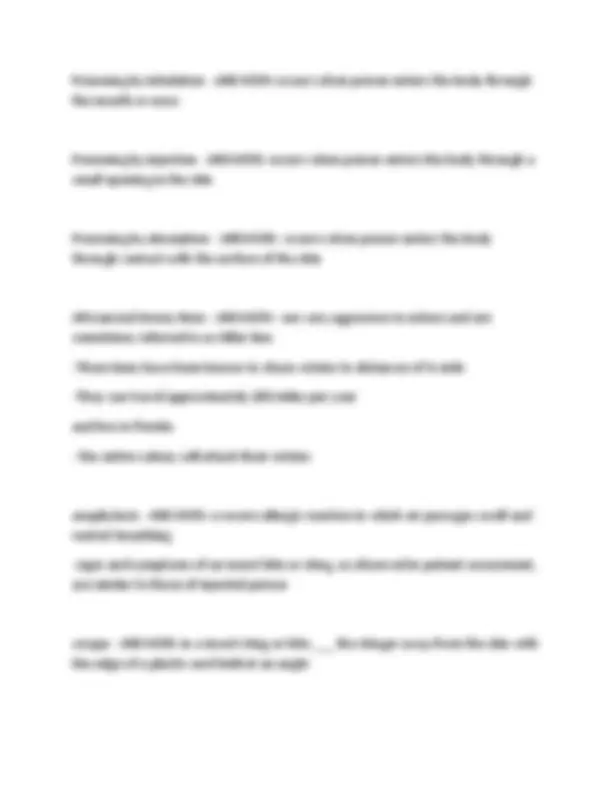
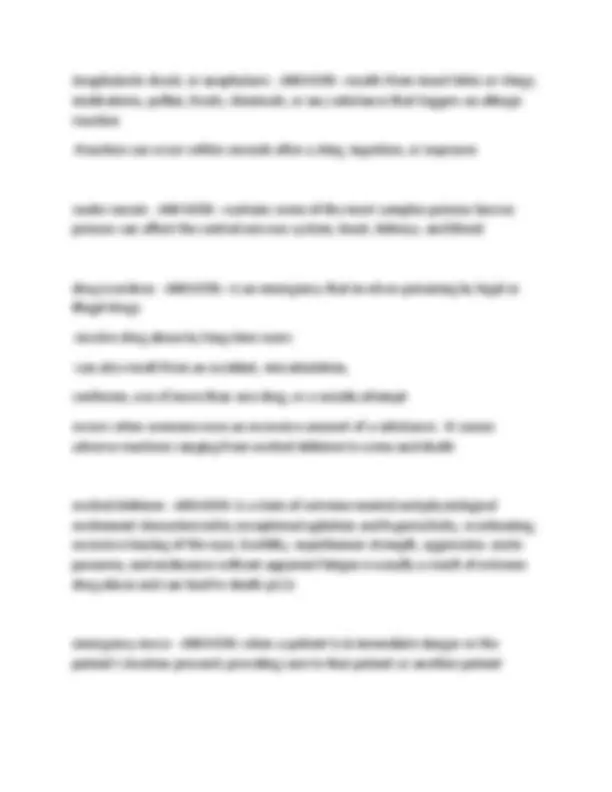
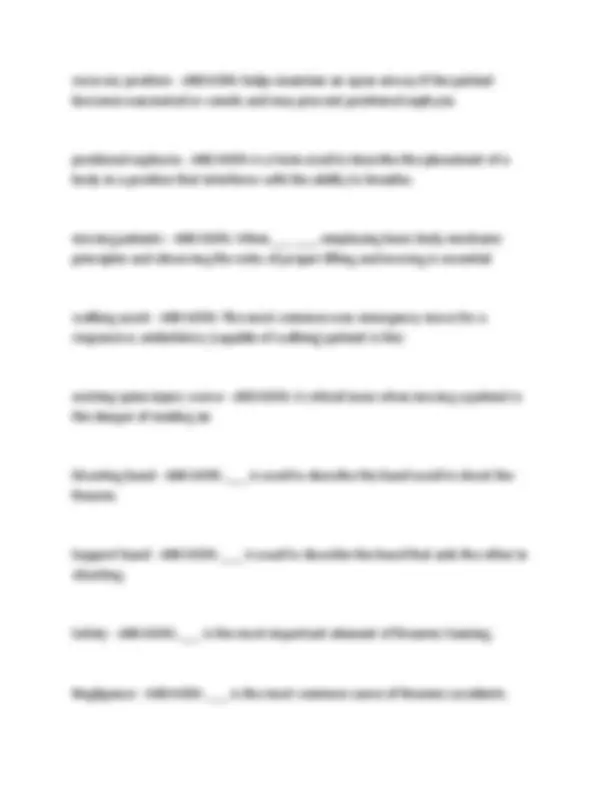
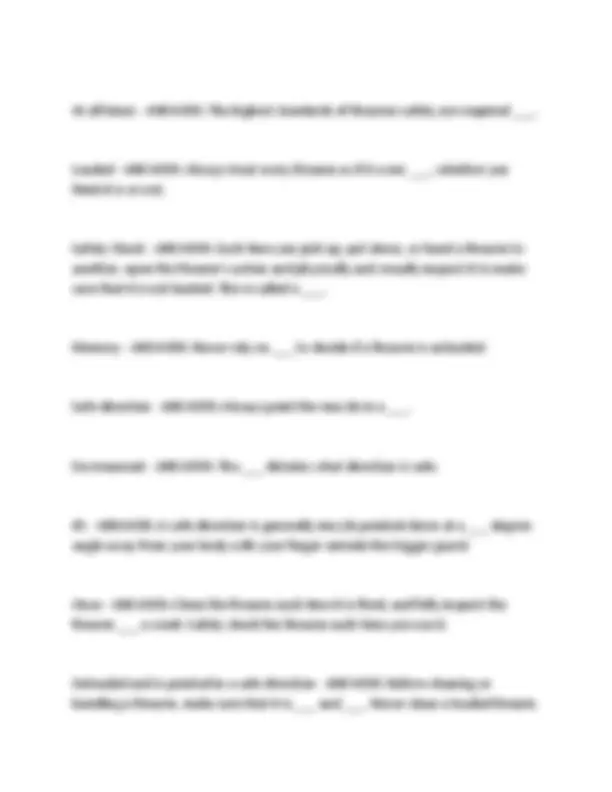
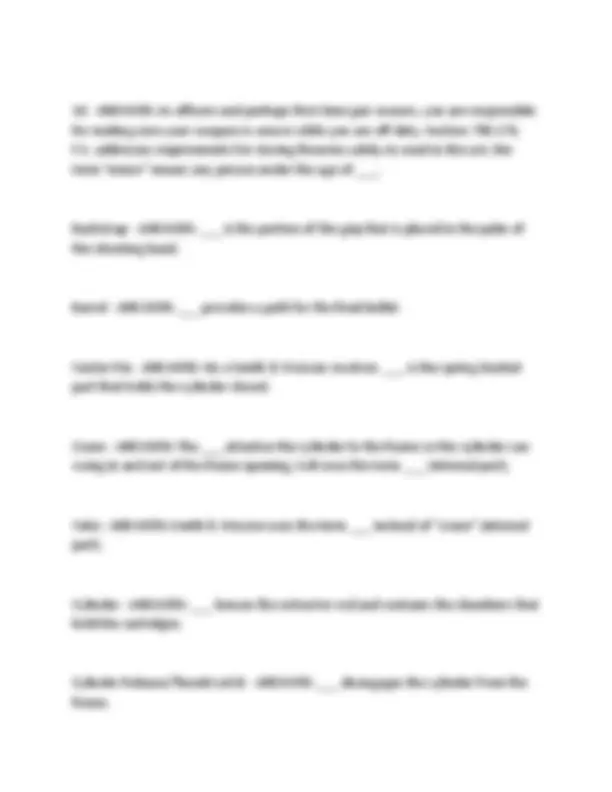
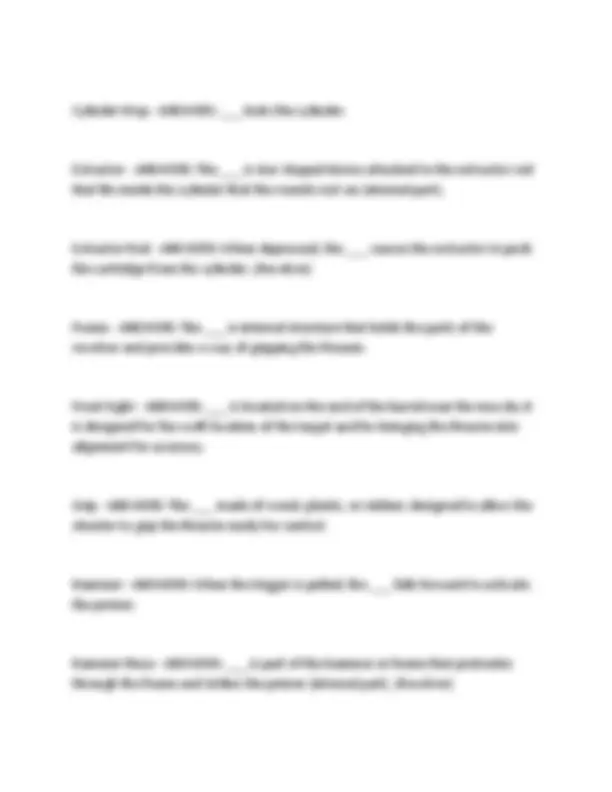
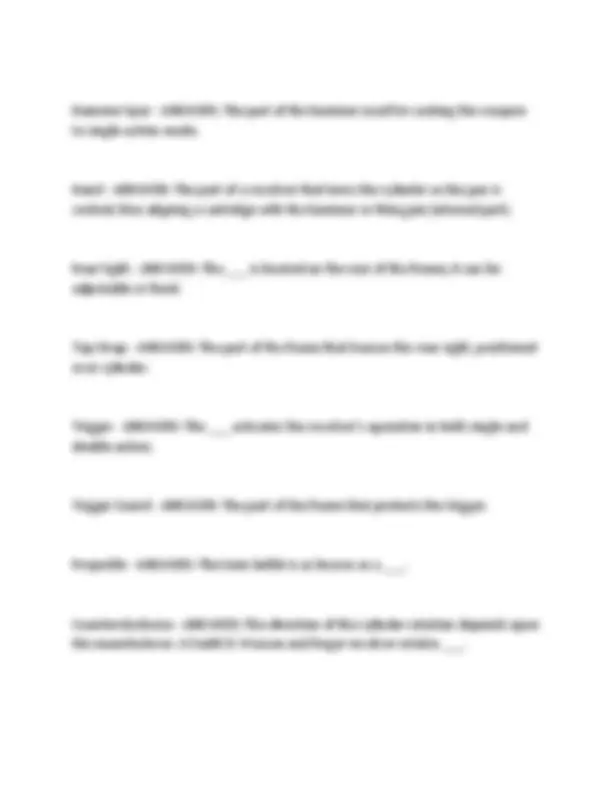
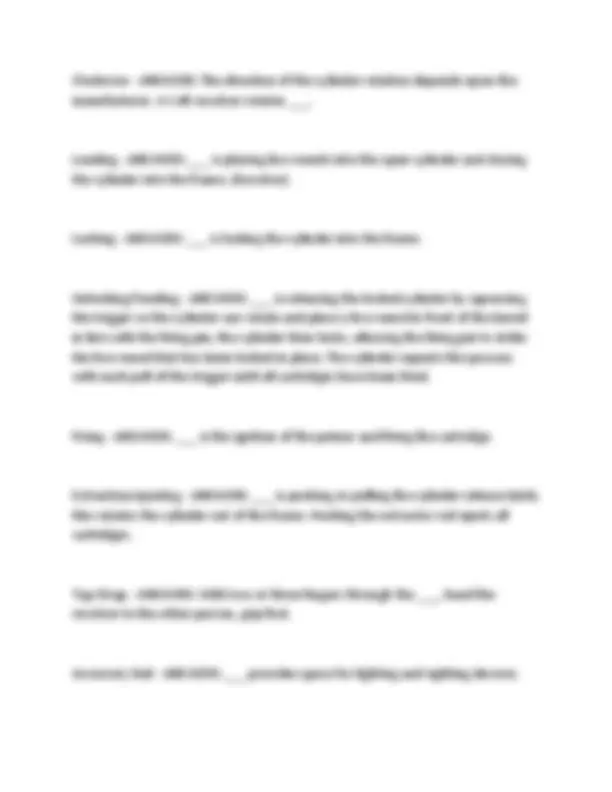
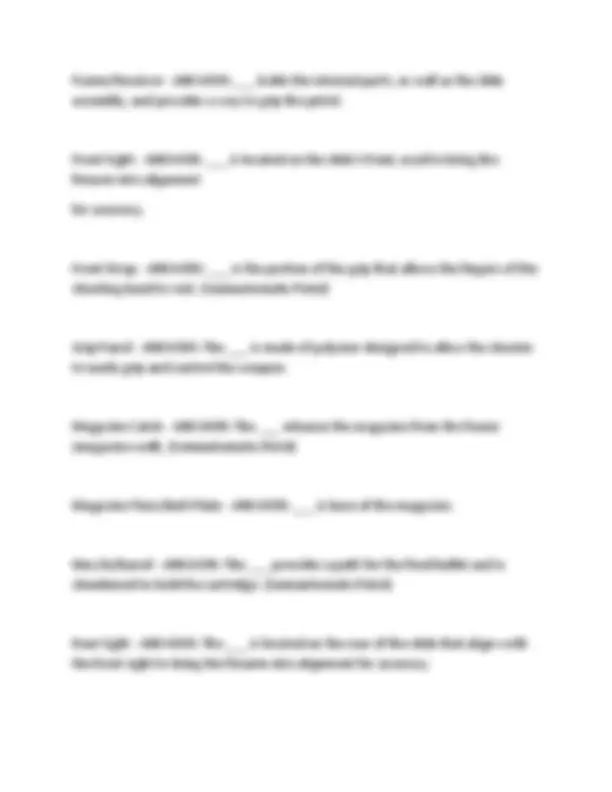
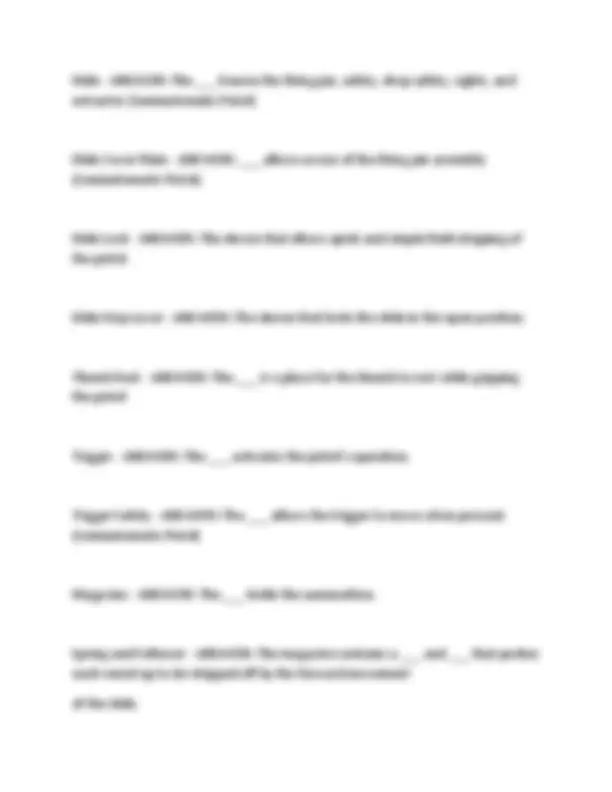
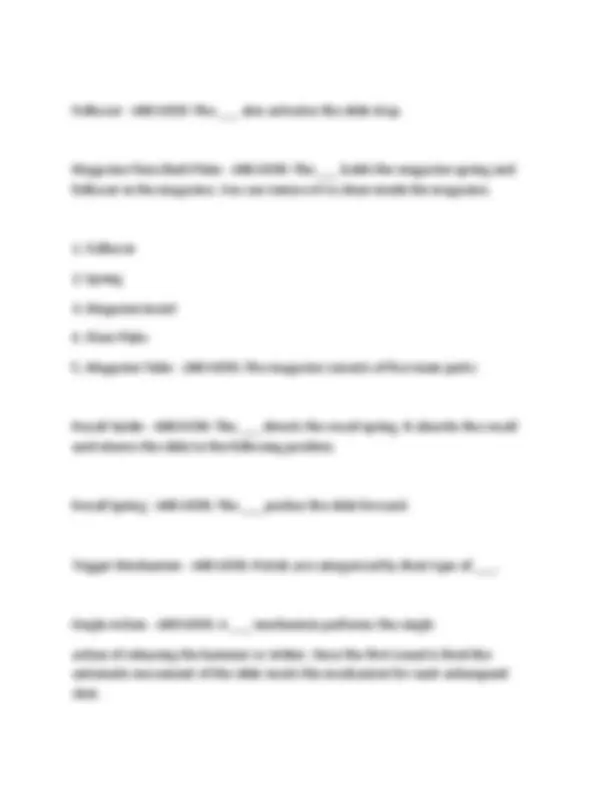
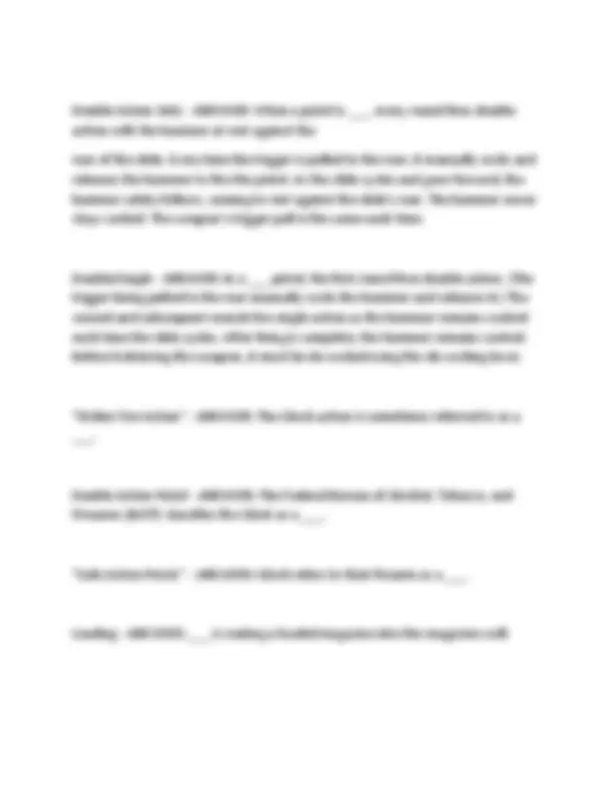
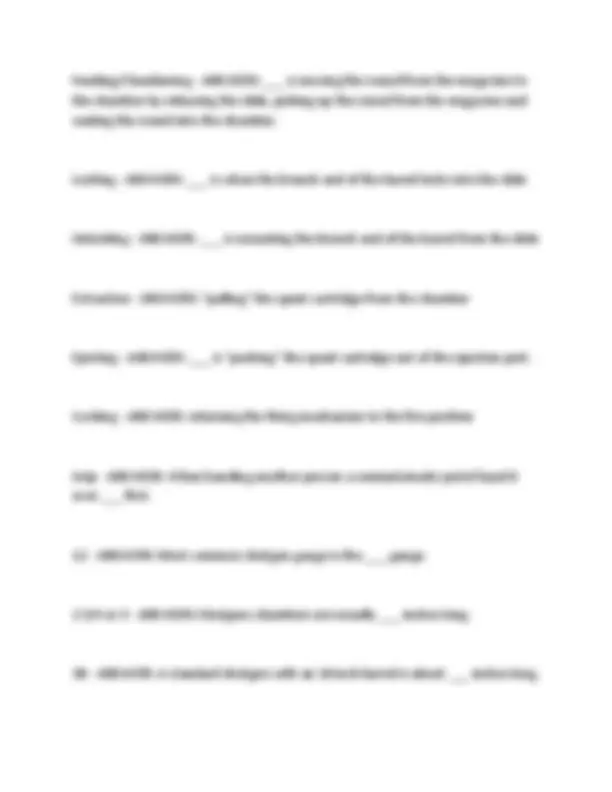
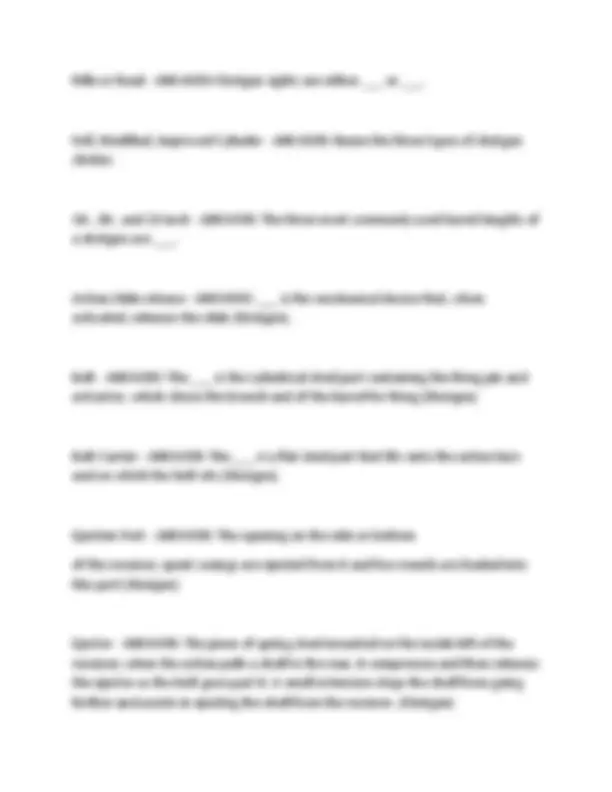
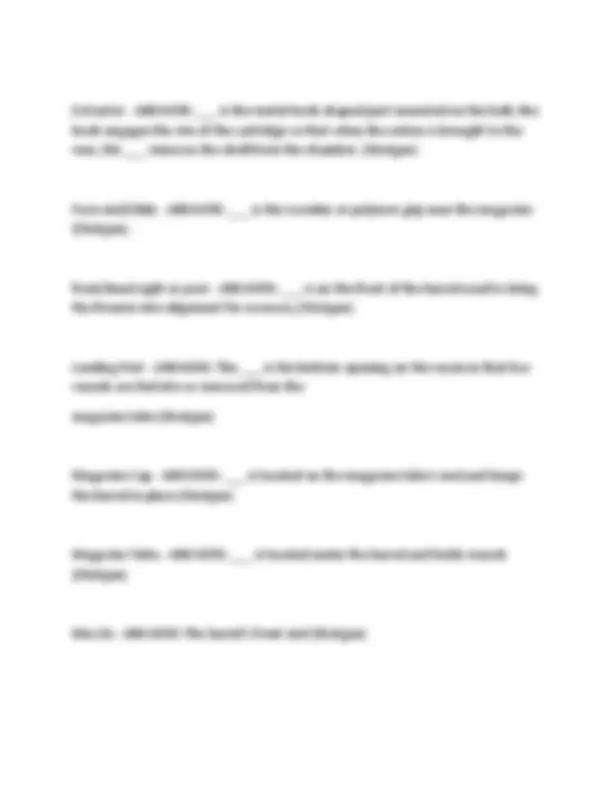
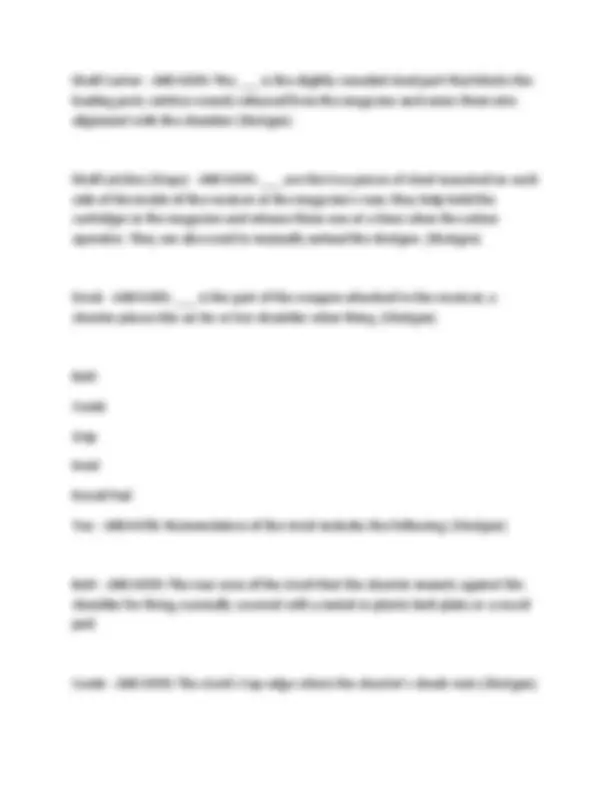
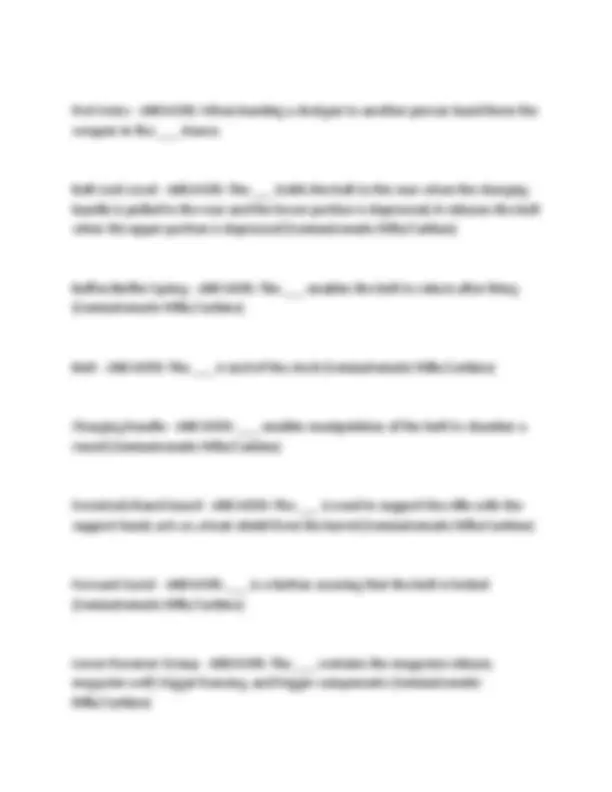
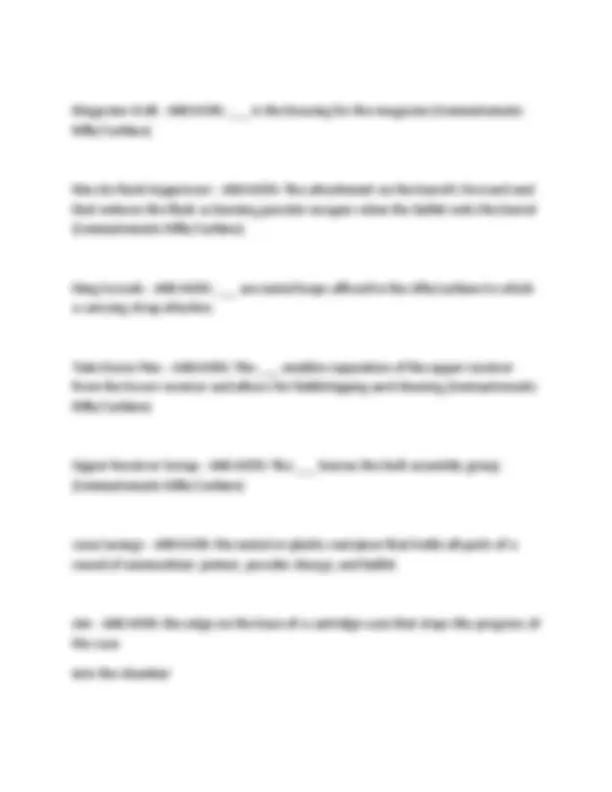
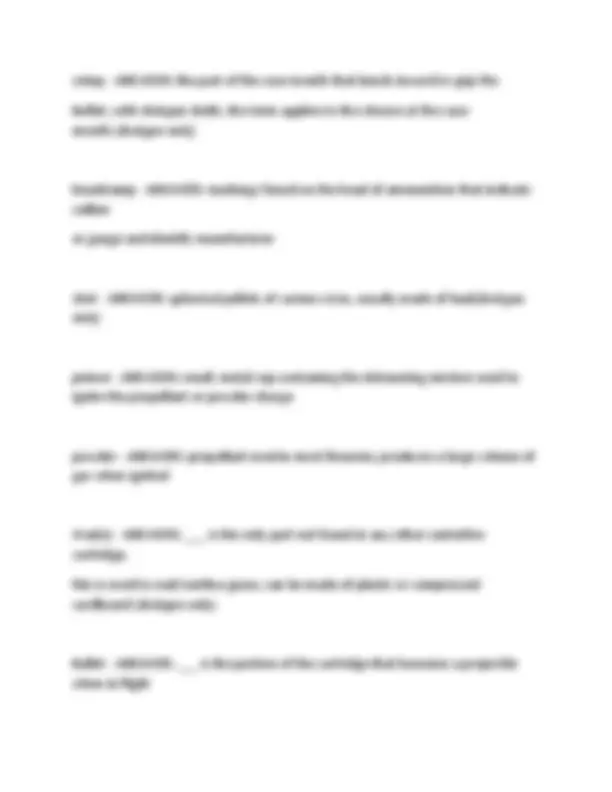
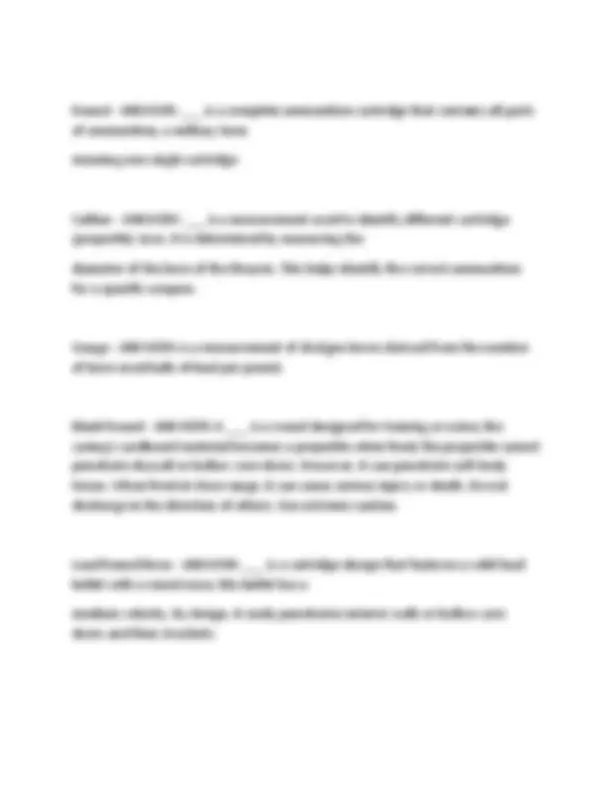
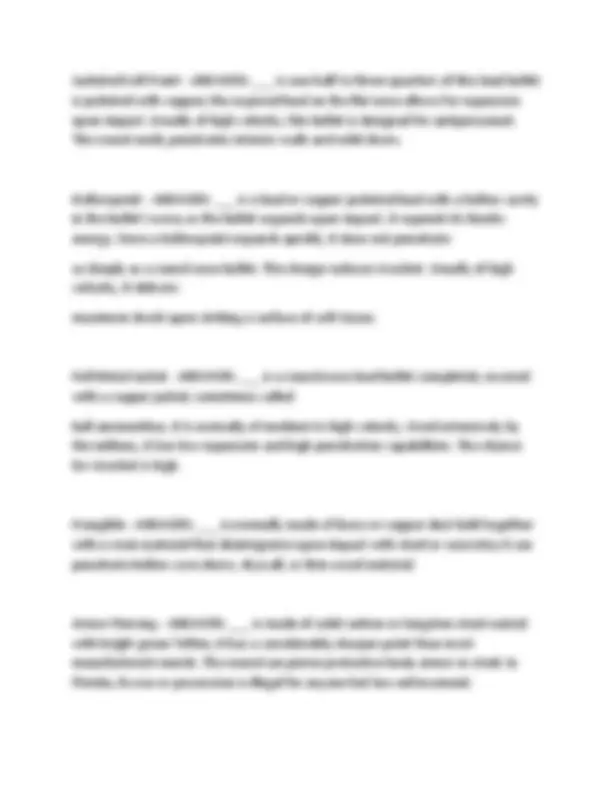
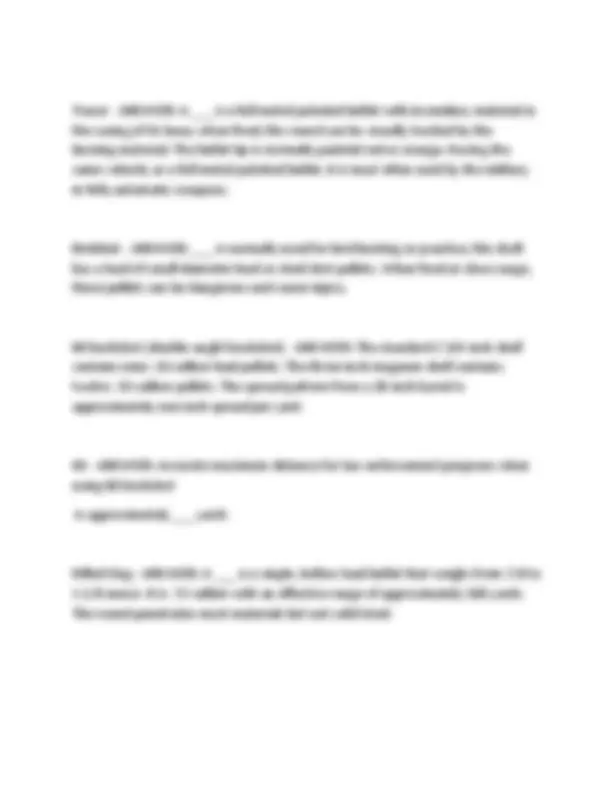
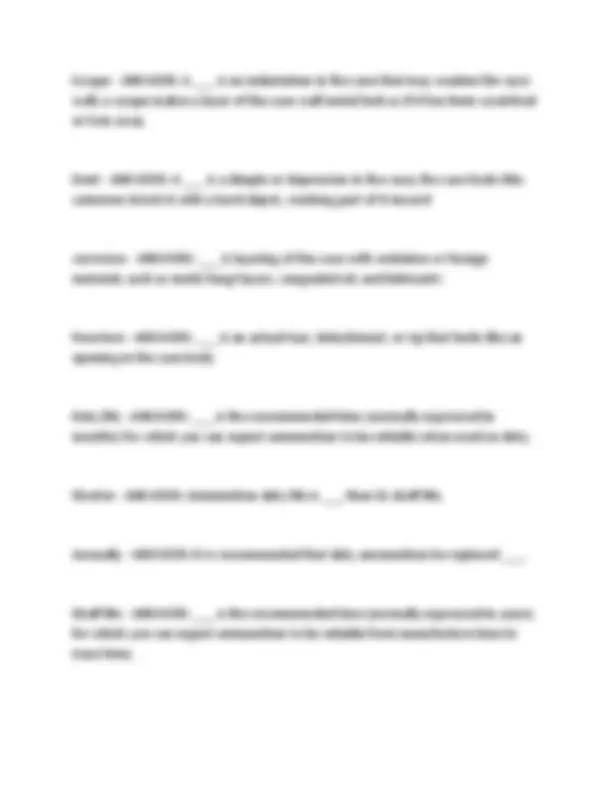
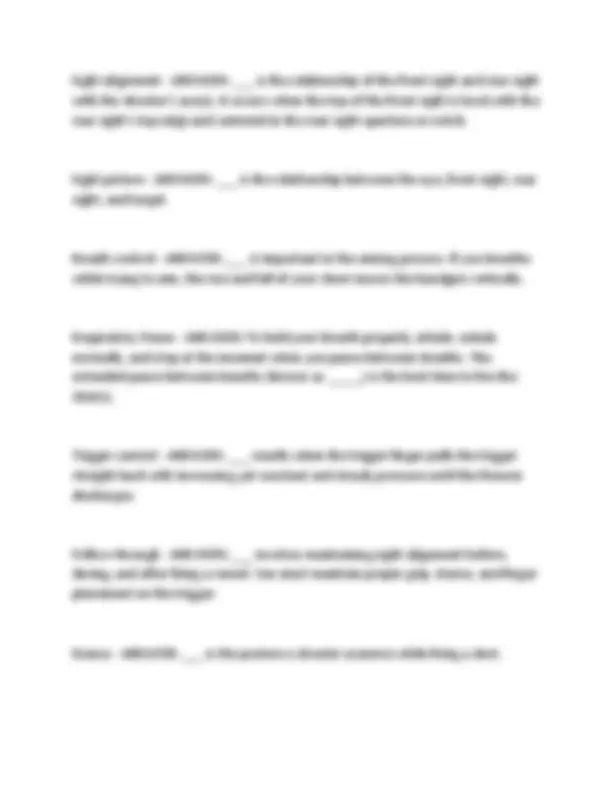
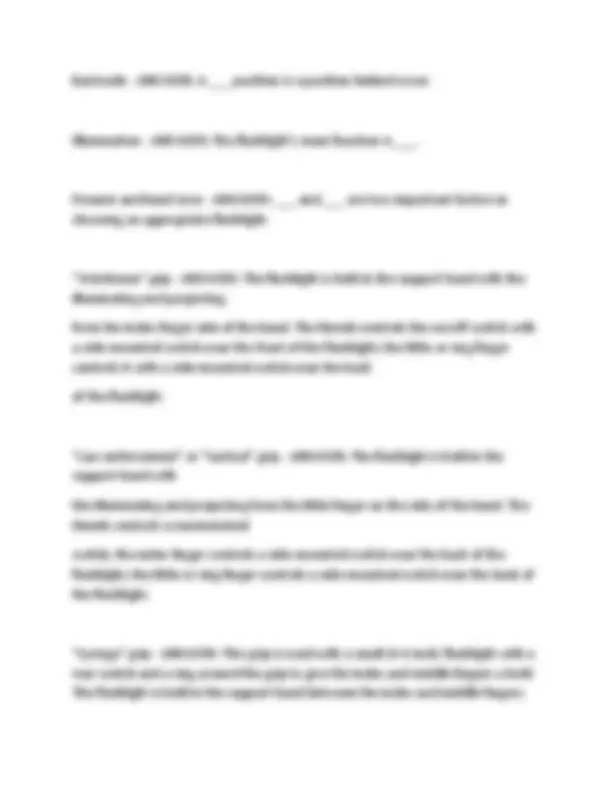
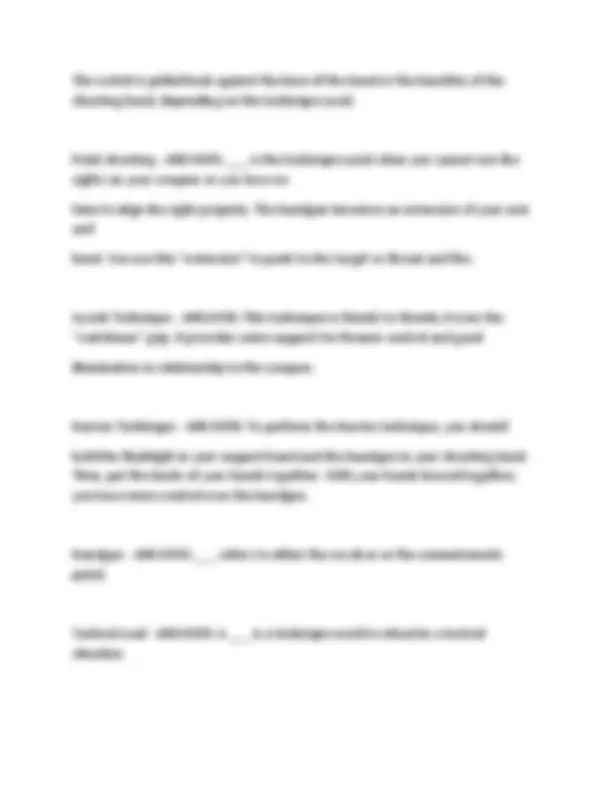
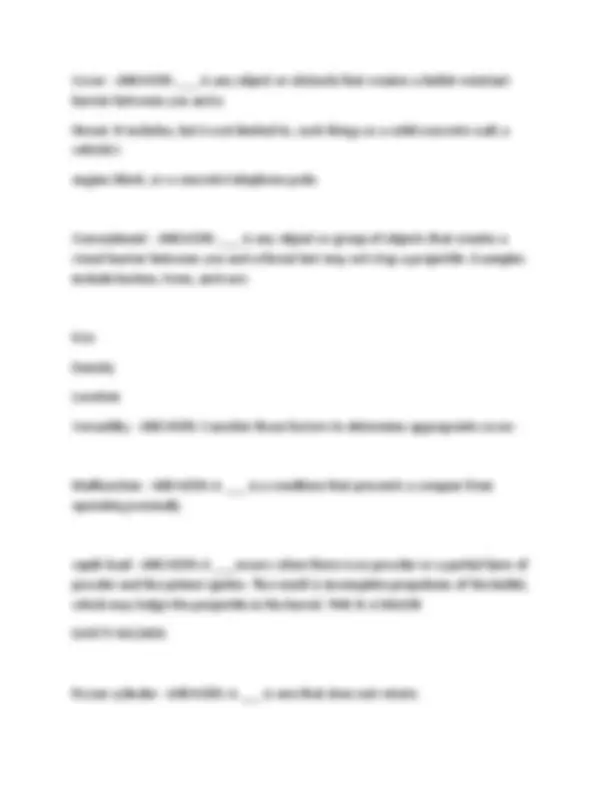
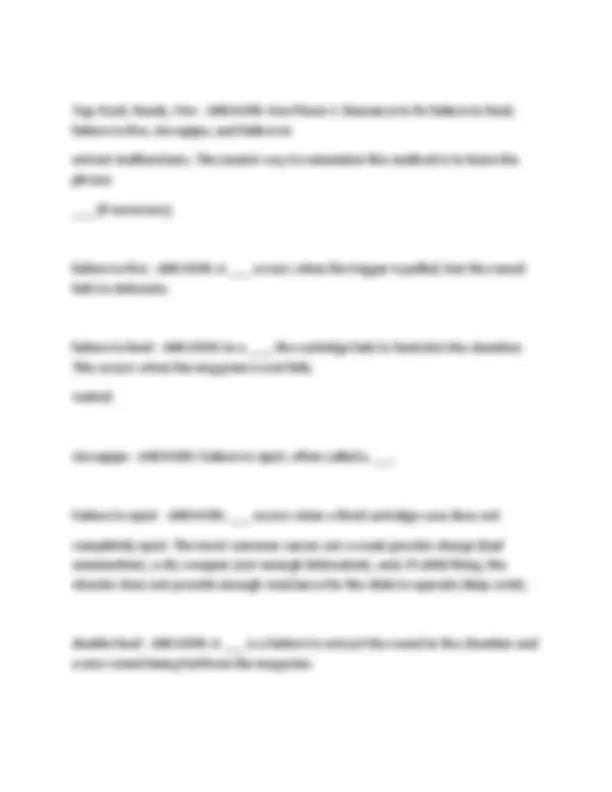
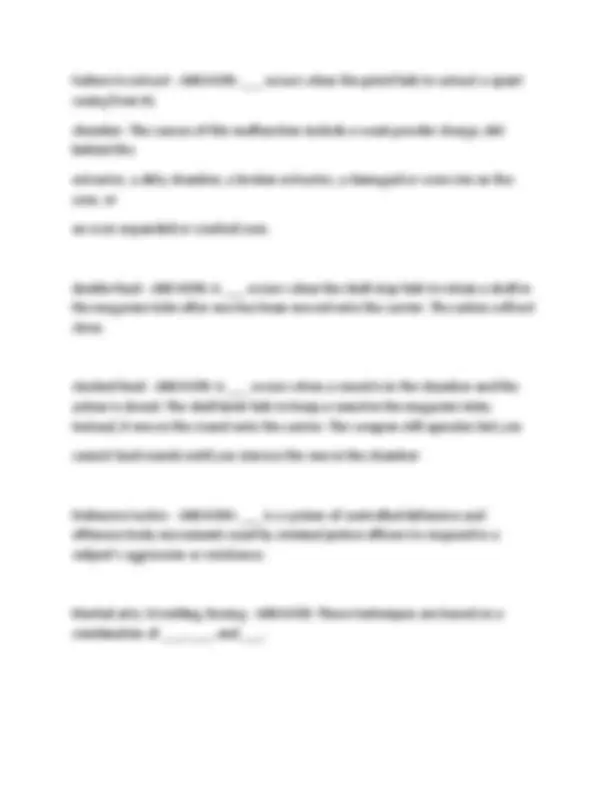
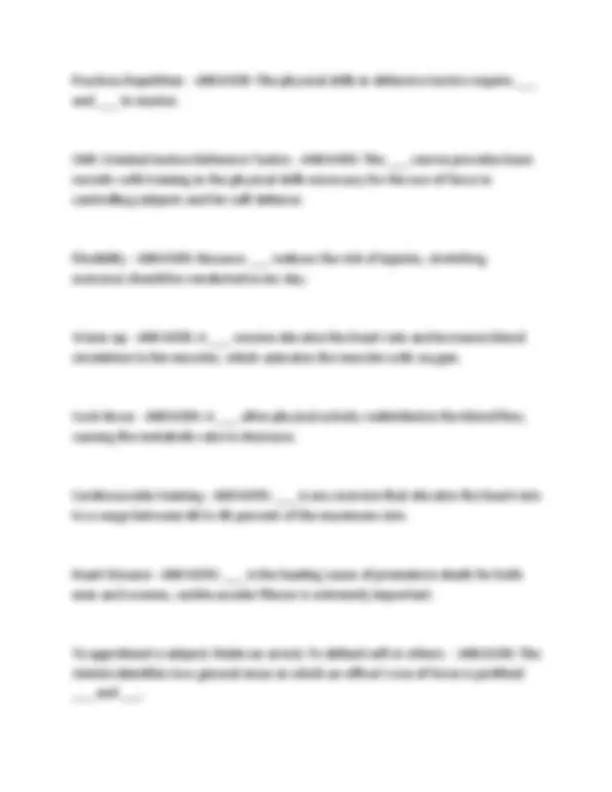
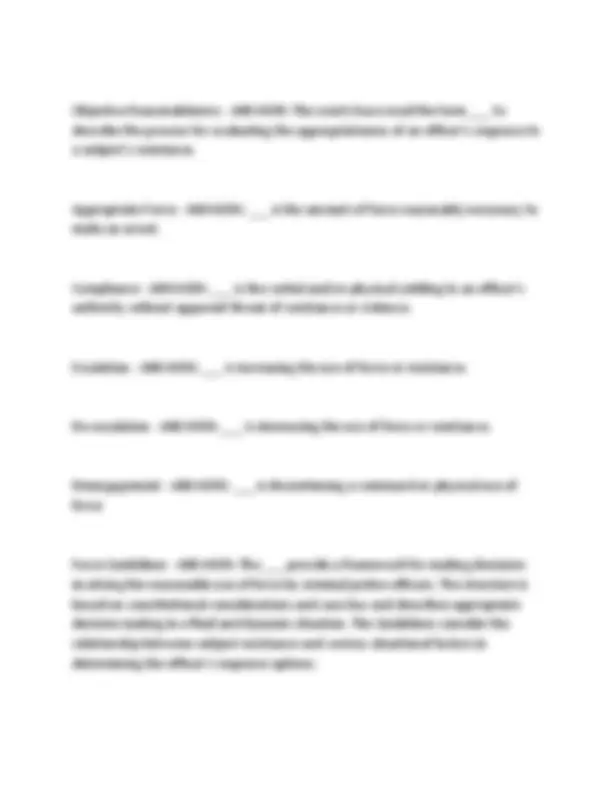
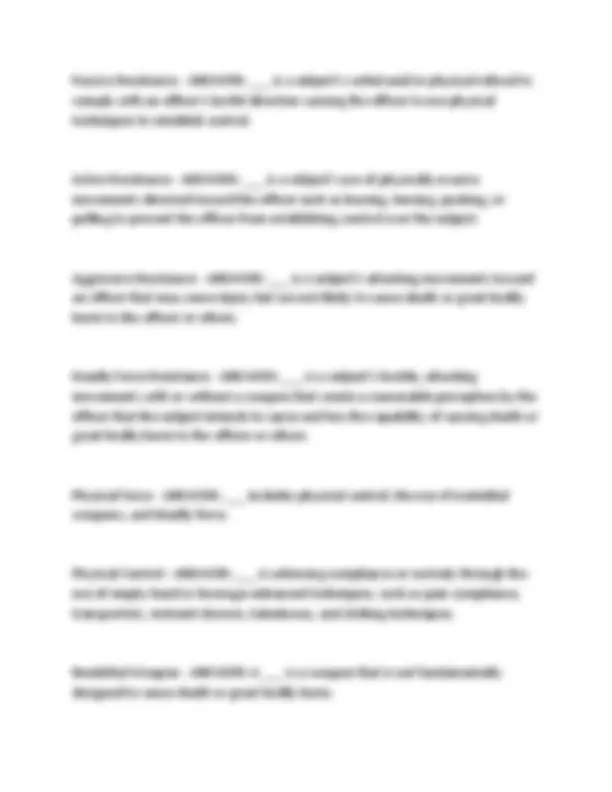
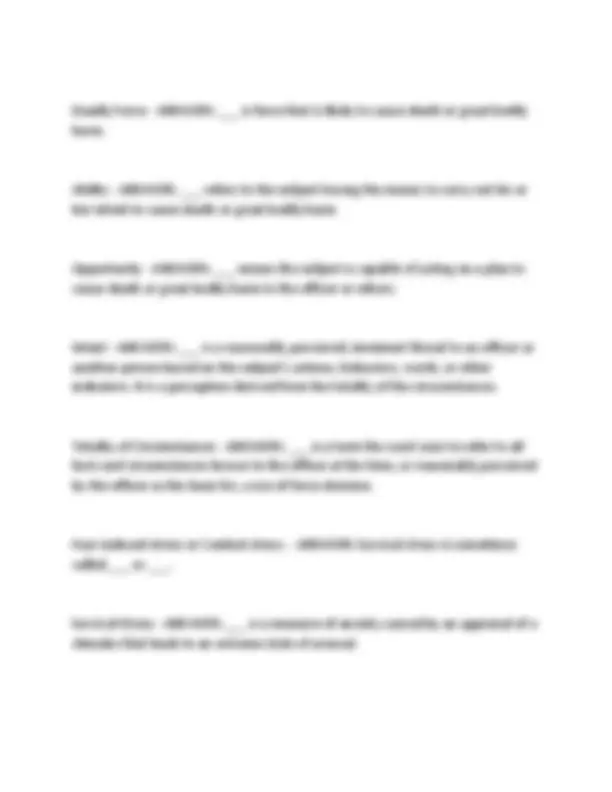

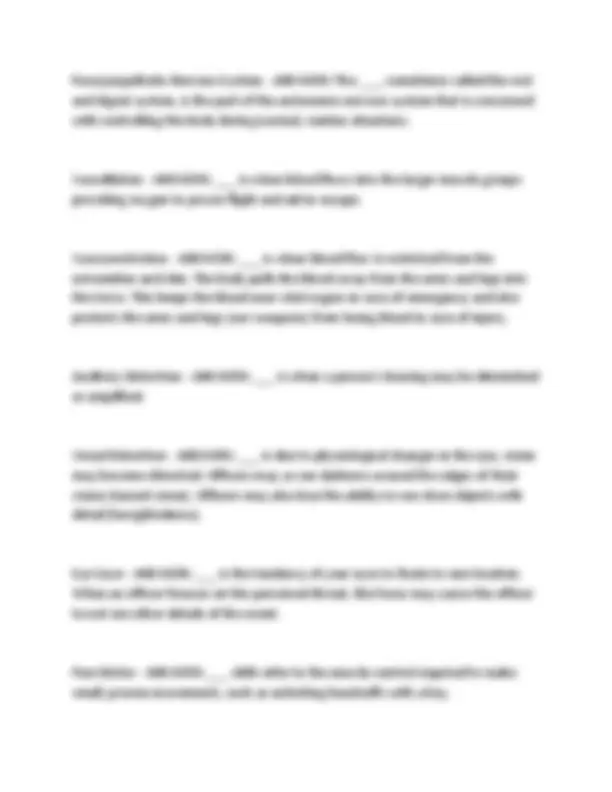
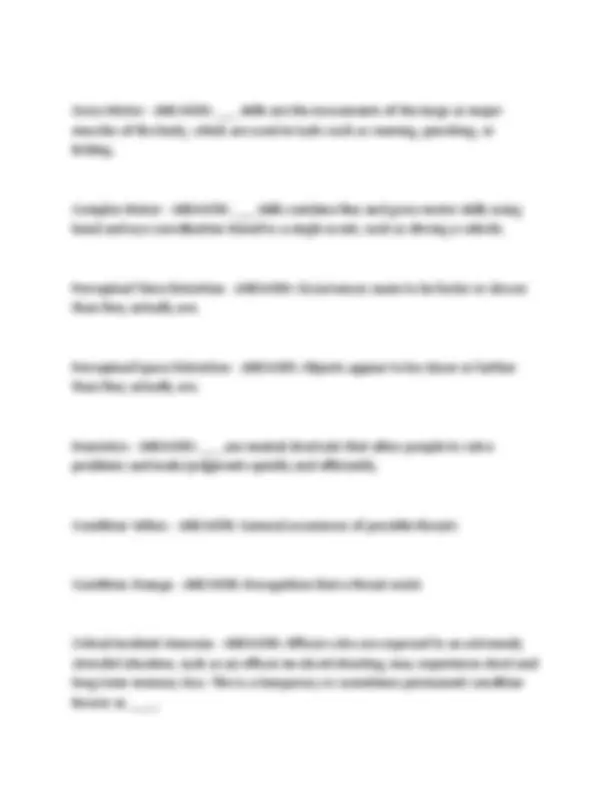

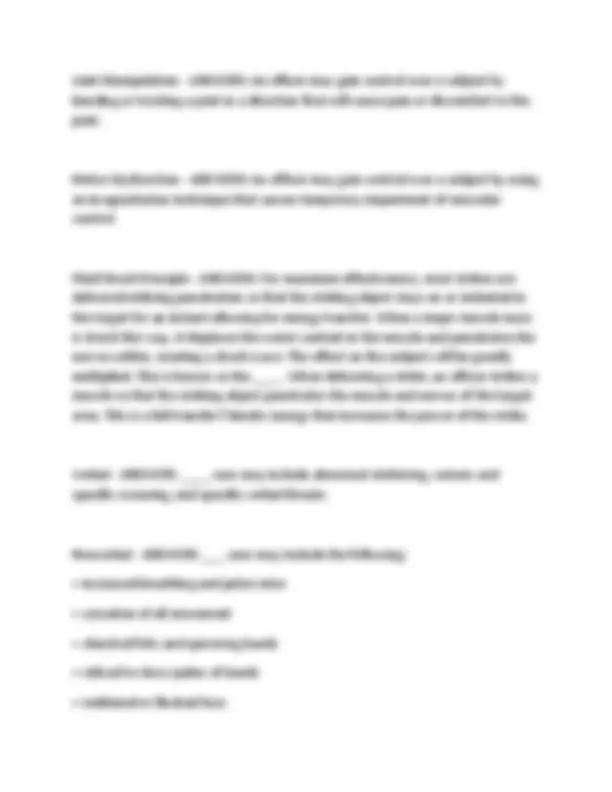
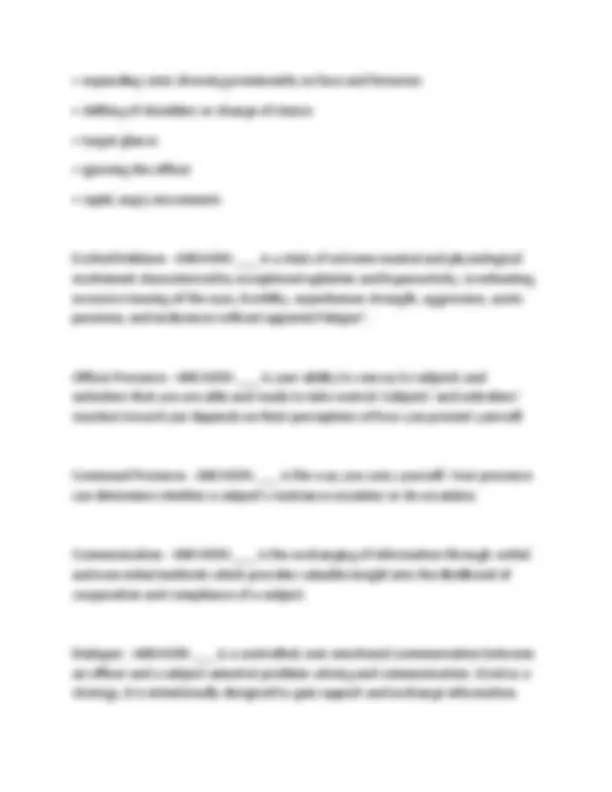
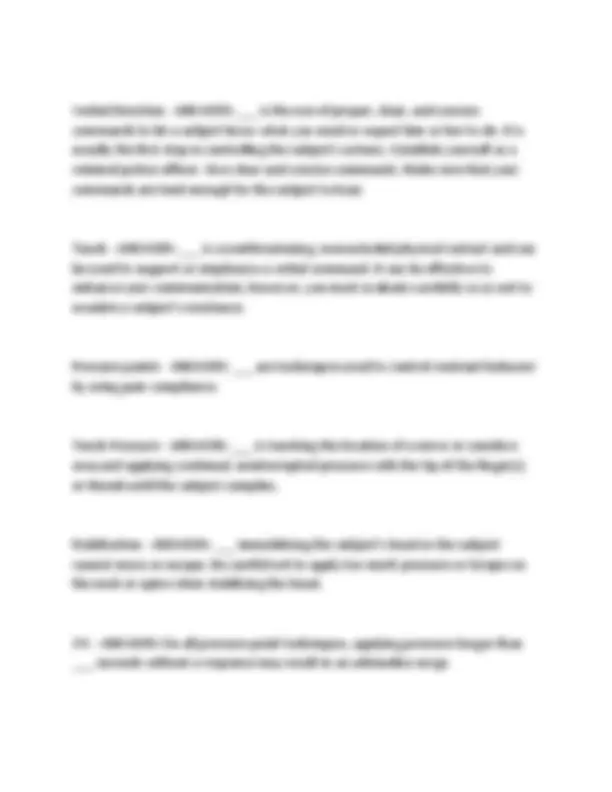
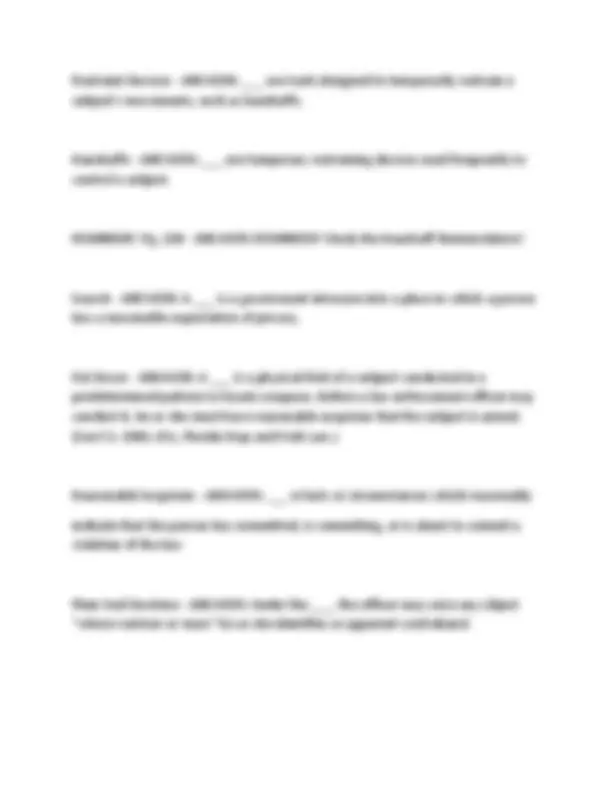
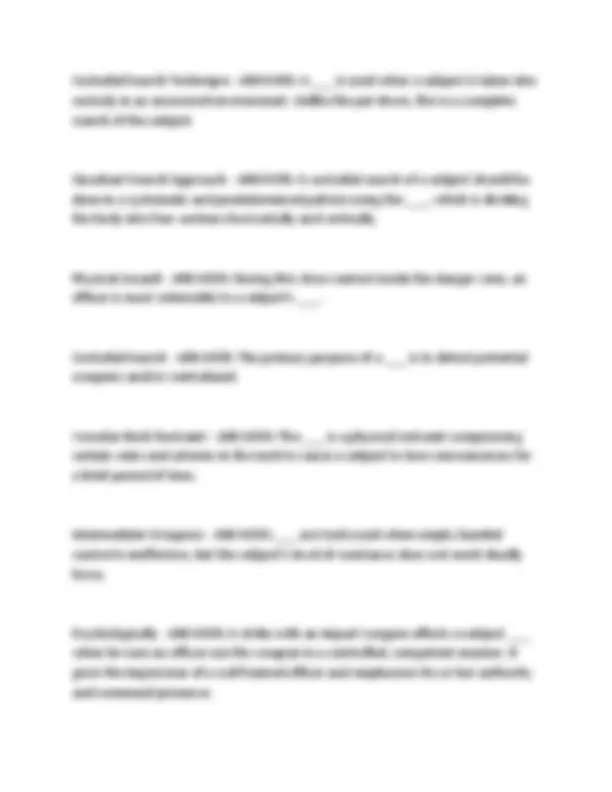
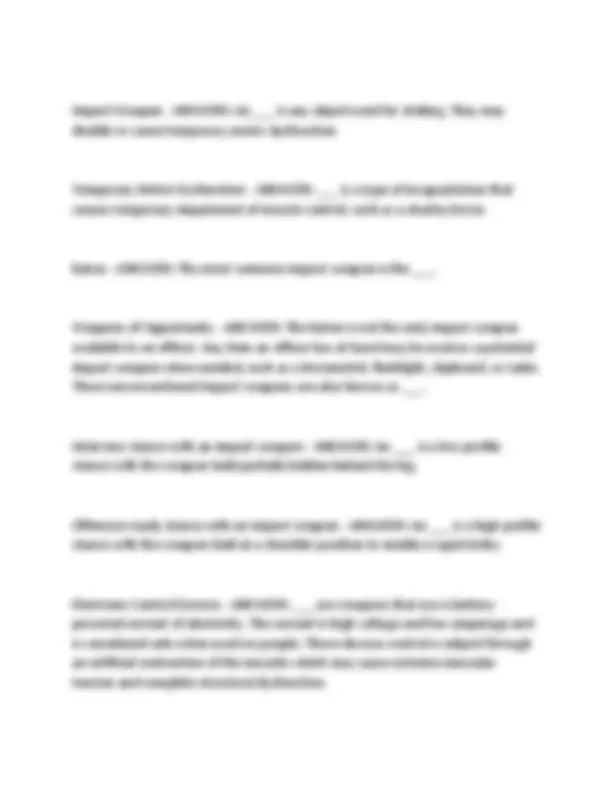



Study with the several resources on Docsity

Earn points by helping other students or get them with a premium plan


Prepare for your exams
Study with the several resources on Docsity

Earn points to download
Earn points by helping other students or get them with a premium plan
Community
Ask the community for help and clear up your study doubts
Discover the best universities in your country according to Docsity users
Free resources
Download our free guides on studying techniques, anxiety management strategies, and thesis advice from Docsity tutors
HIGH LIABILITIES SOCE REVIEW EXAM WITH CORRECT ACTUAL QUESTIONS AND CORRECTLY WELL DEFINED ANSWERS LATEST 2025 ALREADY GRADED A+
Typology: Exams
1 / 100

This page cannot be seen from the preview
Don't miss anything!





























































































Grip - ANSWERS-The "small of the stock," just behind the receiver; the shooter uses the ___ and his or her shooting hand for control when firing or carrying it (Shotgun)
Heel - ANSWERS-The ___ is the top corner of the butt (Shotgun)
Recoil Pad - ANSWERS-___ is a butt plate, usually rubber, that reduces the effect of the shotgun's recoil or "kick" (Shotgun)
Trigger Gaurd - ANSWERS-A ___ is the part of the frame that protects the trigger (Shotgun)
Chambering - ANSWERS-___ is removing a round from the magazine tube and placing it in the barrel's chamber by cycling the weapon, or after placing a round in the open ejection port, pushing the slide forward (Shotgun)
exterior - ANSWERS-After inspecting a vehicle's ____, do not drive it without checking under the hood
front tire - ANSWERS-If the _____ fails, the vehicle may lose traction. You may have difficulty steering, feel vibration in the steering wheel, and feel the vehicle pulling in the direction of the affected tire
rear tire - ANSWERS-If the ____ fails, the vehicle may also lose traction and pull in an unpredictable direction.
belts - ANSWERS-should be checked for fraying, cuts, cracking, and gouges
hoses - ANSWERS-should be checked for dry rot, cracking, holes, bulges, and leak
PSI - ANSWERS--proper tire inflation ensures tires are inflated at or above the manufacturer's recommended
-can be found on the doorjamb
liability - ANSWERS-An officer creates potential for ____ if something happens because of a vehicle problem,
especially if inspection and correction could have prevented that problem
it (standing to the side of the vehicle, not in front of it) to check for leaks that may not be apparent when the vehicle is off. After completing this check, you can
acuity - ANSWERS-sharpness of vision
depth perception - ANSWERS-ability to judge distance and perceive space to determine how far away an object is ____
peripheral vision - ANSWERS-ability to see above, below, and to the sides (A person who is in a stationary vehicle and who has good peripheral vision can see about 180
degrees from side to side.)
color vision - ANSWERS-ability to distinguish colors
night vision - ANSWERS-ability to see clearly in darkness
90-95 percent - ANSWERS-Vision supplies approximately ______ of incoming data to a driver. It gives valuable information needed to detect and avoid hazards
Environmental and physical conditions, alertness, and aging are - ANSWERS- factors that affect vision
hearing - ANSWERS-lets officers locate the source of sounds that may indicate a problem with a vehicle, a suspicious
incident, or a crime
touch - ANSWERS-can help an officer detect problems that can affect vehicle operation and control
keen observer and be aware of hisor her surroundings - ANSWERS-Several techniques can enhance an officer's ability to be a
damaged or altered surfaces - ANSWERS-may include potholes and sinkholes, curbs, and railroad tracks
rain - ANSWERS--can cause a vehicle to lose traction and skid out of control
-even a small amount of ___ can cause a car to float off the road
intersections - ANSWERS-Officers should be especially careful at ____, as they represent the single greatest threat to safe
vehicle operation
steer - ANSWERS-to a safe location in the direction you want to go is also a good tactic for avoiding a crash
yaw - ANSWERS-is the transfer of a vehicle's weight causing an end-for-end motion resulting in the vehicle turning 180 degrees on a horizontal plane
directional stability - ANSWERS-affects the degree of pitch, roll, and yaw that a vehicle experiences
stability - ANSWERS-The higher a vehicle's center of gravity, the lower its ____
equipment and passenger loads - ANSWERS-affect weight transfer and could change a police
vehicle's stability
weight transfer and distribution - ANSWERS--occurs when the vehicle's speed changes and
influences the vehicle's handling ability
-also occurs when a vehicle changes direction
weight - ANSWERS-is distributed only where the tires contact the surface
forward or backward - ANSWERS-As a driver applies the brakes, weight transfers in the direction the vehicle is traveling _____
radius - ANSWERS-is the distance from the center of a circle to the outside of the circle. A turn or curve is a portion of a circle
increasing radius - ANSWERS-is a turn that gets wider during the turn much like a circle getting larger
decreasing radius - ANSWERS-is a turn that gets tighter during the turn much like a circle getting smaller
constant radius - ANSWERS-is a turn that remains the same throughout, getting neither wider nor smaller
apex - ANSWERS--is the center point of any curve
apexing technique - ANSWERS-- is how the vehicle is steered in relation to a curve's apex while maintaining your lane
-is when the vehicle is steered so it is closest to the inside of the curve before reaching the apex
of control
center apexing technique - ANSWERS-is when the vehicle is steered closest to the middle of the curve
late apexing technique - ANSWERS--is when the vehicle is steered so it passes closest to the inside of the curve after reaching the apex
understeer - ANSWERS-is the tendency of a vehicle to turn less sharply than the driver intends. The cause of ____ may be a combination of excessive speed, lack of traction on the steering tires, and improper braking in a
turn or curve
Oversteer - ANSWERS-____ is the tendency of a vehicle to steer into a sharper turn than the driver intends, sometimes with a loss of traction of the rear to the outside. ____
generally occurs at higher speeds when the rear tires lose traction and excessive braking occurs in a turn or curve
wheel tracking - ANSWERS-is an occurrence that causes the rear wheels to follow a tighter path than the path the front wheels traveled in a turn
optical driving or eye targeting - ANSWERS-is looking in the desired direction of travel to avoid an obstacle and steering in that direction
ABS-anti-lock braking system - ANSWERS--is now standard equipment on late model vehicles
incipient skid - ANSWERS-_____ happens just before the tires lose traction during braking. The tires lock, causing loss of steering control and a skid
incipient spin - ANSWERS-occurs just before the drive tires lose traction during acceleration. (The drive tires are the front tires on a front-wheel drive vehicle or rear tires on a rearwheel drive vehicle.)
proper acceleration - ANSWERS-It is important to remember that ____ is best done in a smooth, straight line using steady pressure
traction - ANSWERS-Control of a vehicle depends on traction. _____ is the result of the friction a vehicle's tires create on the road surface
rolling friction - ANSWERS-The best traction is _____, which is when the tires constantly rotate on the road surface without losing contact
skid - ANSWERS-results when the wheels lock and do not turn while the vehicle is moving -weight transfer and centrifugal force can also influence a ____
slide - ANSWERS--also results from loss of both rolling friction and traction. In a _____, the wheels still rotate, but they do not control the vehicle's movement - can cause loss of control
power slide - ANSWERS-_____ happens when a driver over-accelerates, and the tires spin: the wheels are not locked, but the
driver has lost traction
emergency lights - ANSWERS-When driving in emergency mode,_______ can
increase the amount of glare encountered. The high intensity of the _____ easily reflects off objects
physiological effects - ANSWERS-are the measurable changes to normal body functions.....tunnel vision, selective hearing,
increased heart rate, time distortion, and loss of spatial awareness or fine motor skills
fleeing violator - ANSWERS-goal of pursuit is to apprehend a ____
pursuit - ANSWERS-an active attempt by an officer, driving an authorized emergency vehicle (with emergency equipment activated), to apprehend occupants of a moving vehicle if the offender increases vehicle speed, takes other evasive actions, or refuses to stop in an apparent attempt to avoid apprehension
DeShaney v. Winnebago County Department of Social Services - ANSWERS-the U.S. Supreme Court stated that an officer or agency has no duty to guarantee a person's safety unless a special relationship exists between the police and that person
City of Pinellas Park v. Brown - ANSWERS-law enforcement has a duty to protect the public when choosing to continue a pursuit
Brower v. Inyo County - ANSWERS-the U.S. Supreme Court addressed the issue of deadly force in a police pursuit
County of Sacramento v. Lewis - ANSWERS-the Supreme Court adopted the standard referred to in earlier cases involving force
notify dispatch - ANSWERS-Once engaged in a pursuit, an officer must_____ that he or she is initiating or terminating a pursuit
at least temporarily.
roadblock - ANSWERS-A ______ is the use of vehicles, barricades, cones, or other objects to block traffic flow completely. Its purpose is to demonstrate overwhelming police superiority and position so that the violator will stop and surrender
Brower v. County
breach of duty - ANSWERS-occurs when you either fail to act or act inappropriately-p
standard or scope of care - ANSWERS--the degree of care that a reasonable person should exercise
-is care that you are expected to provide to the same patient under the same conditions as would any criminal justice first aid provider who received the same level of training-p34/
Good Samaritan Act - ANSWERS--enacted in 1959 in California
-provides protection from civil suits to physicians who render emergency care
-protect a civilian first aid provider from liability for medical care performed in good faith or medical care similar to that expected of another first aid provider with equal training
-protects LEOs when they are acting outside their jurisdictions
-does not stop someone from filing a lawsuit; it does provide a defense if you performed according to the standard of care for a first aid provider-p
abandonment - ANSWERS-relinquishing of a right or interest with the intention of never again claiming it-p
negligence - ANSWERS-the failure to exercise the standard of care that a reasonably prudent person would have exercised in a similar situation; any conduct that falls below the legal standard established to protect other against unreasonable risk of harm, except for conduct that is intentionally, wantonly, or willfully disregardful of other's rights-p
duty to act, breach of standard of care, causation, and damages - ANSWERS- negligence occurs if all these conditions are present:
-p35/
consent - ANSWERS-agreement, approval, or permission as to some act of purpose, especially given voluntarily by a competent person-p
expressed consent - ANSWERS--consent that is clearly and unmistakably stated
-is affirmative consent, such as verbal or physical assertion of the affirmative-p
implied consent - ANSWERS--consent inferred from one's conduct rather than from one's direct expression
-may be found by circumstantial evidence suggesting implicit consent-p
expressed, implied, informed - ANSWERS-three types of consent
informed consent - ANSWERS-a person's agreement to allow something to happen made with full knowledge of the risks involved and the alternatives
defense against negligence - ANSWERS-your best ___ ____ ____ is to conduct yourself with a professional attitude and demeanor provide consistently high standards of care within the scope of your training, and document the care you provide-p
Do Not Resusciatate (DNR) Order (DNRO) - ANSWERS--a terminally ill patient may have a directive in place, written in advance, and signed by both the
patient and a physician... commonly known as...
-it is legally binding in Fl according to FL Statute s. 401.
-it documents the terminally or chronically ill patient's wish to refuse resuscitation
-p37/
advanced directive - ANSWERS-these documents the patients request to withhold specific medical care-p
criminal justice first aid providers - ANSWERS-___ __ __ ___ do not
have authorization to honor a DNR Order or
an advanced directive-p
medical alert - ANSWERS-a patient who wears an identification bracelet necklace, or carries a card in his or her wallet that alerts you to have a specific medical condition; you may find a phone number to call for detailed information about the patient-p
a signed donor card, or an
organ donor designation - ANSWERS-according
to Florida Statute s. 765.521, has written legal
documentation, ____ ____ ____ on on his or her driver's
license that indicates the patient is an organ
donor-p
HIPAA - ANSWERS--a patient's privacy, medical history, condition, and emergency care are, by law, confidential information
-the patient or a legal guardian must sign a written release before the dissemination of any medical information, except when relaying information to EMS-p
Health Insurance Portability and Accountability Act of 1996 (HIPAA) - ANSWERS- protects the rights of patients and the release of patient information-p
personal safety - ANSWERS-your first concern is ALWAYS
-p
effective communications skills - ANSWERS-when responding to a crisis or medical emergency, ___ ___ __ help you obtain needed information and give reassurance to patients, their families and bystanders
-include not only how you talk and act but also how you present yourself
-p
confident - ANSWERS-characterized by assurance.... full of conviction-p